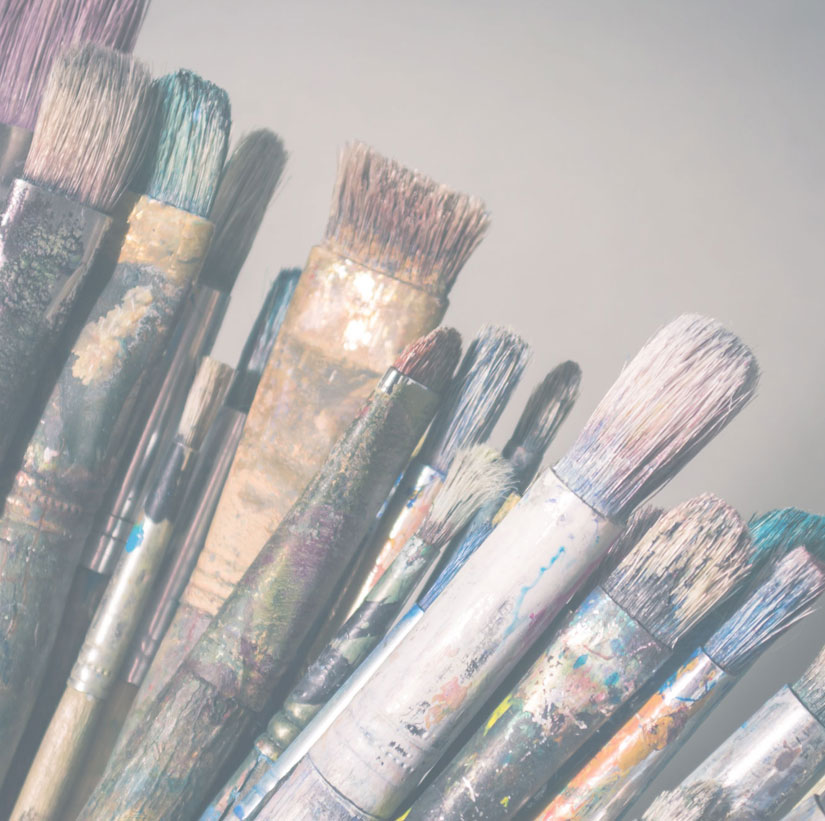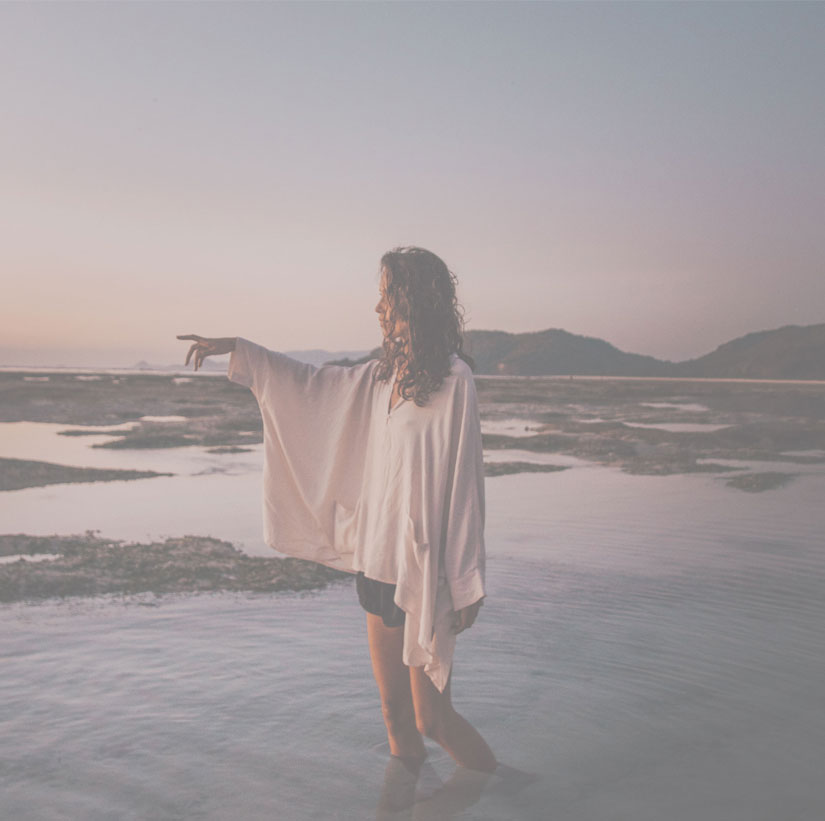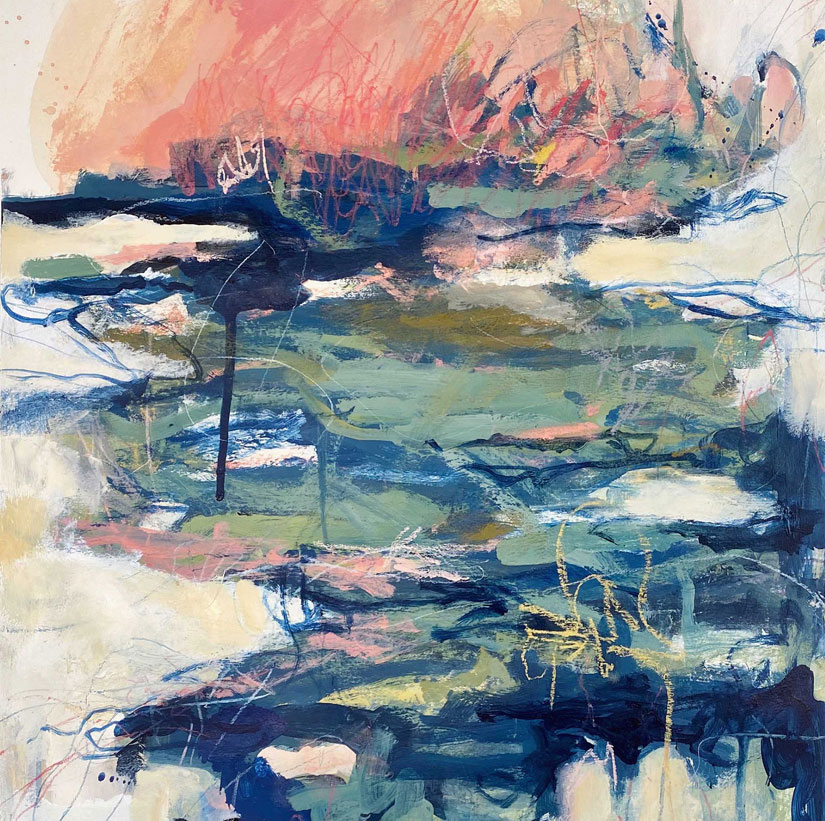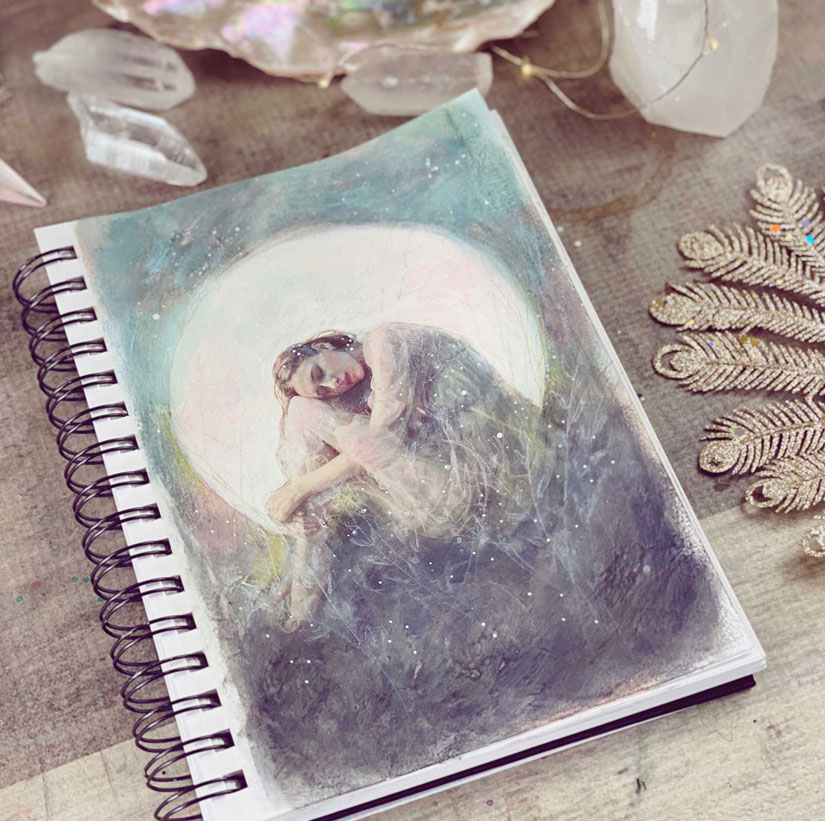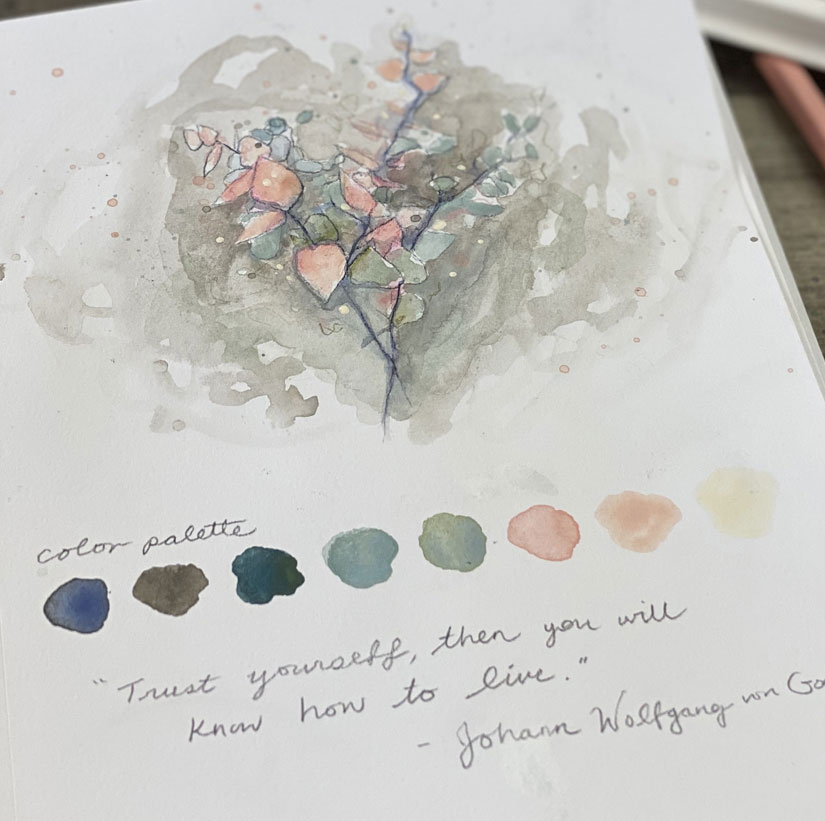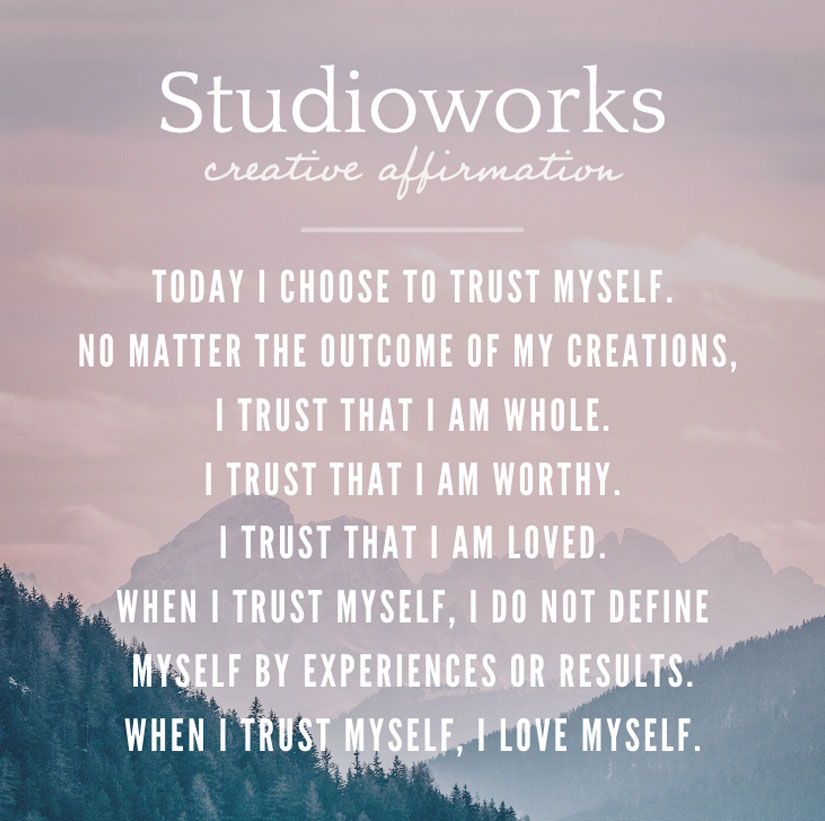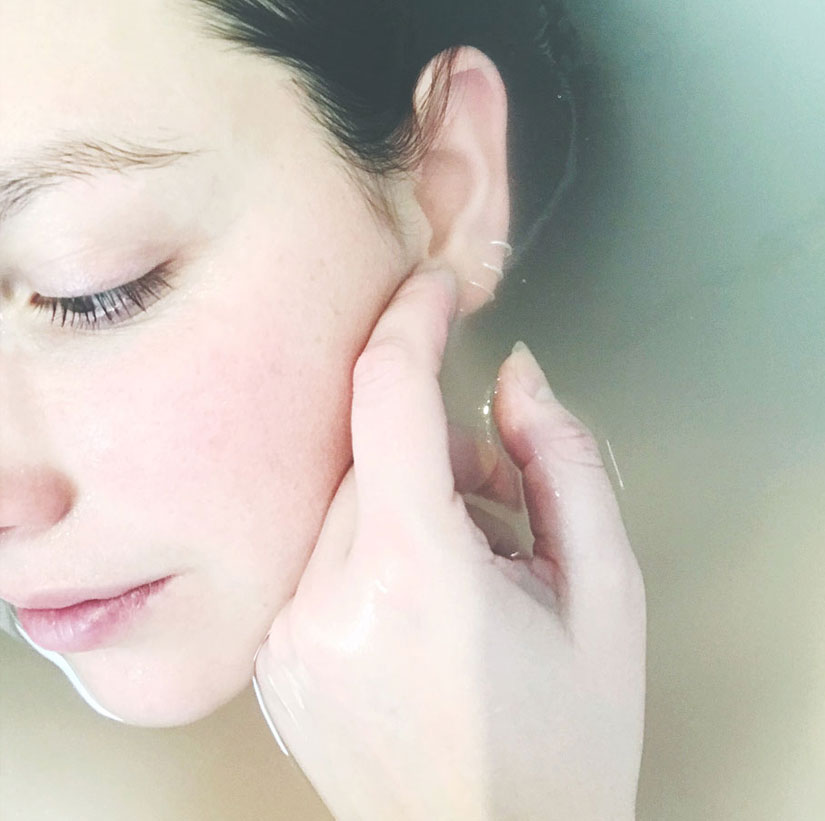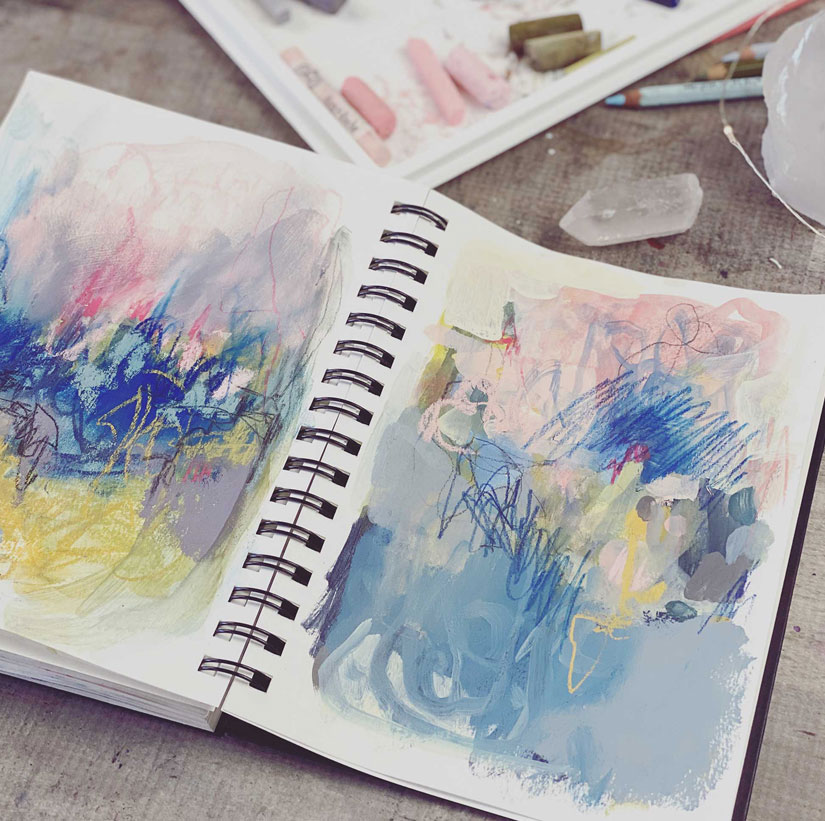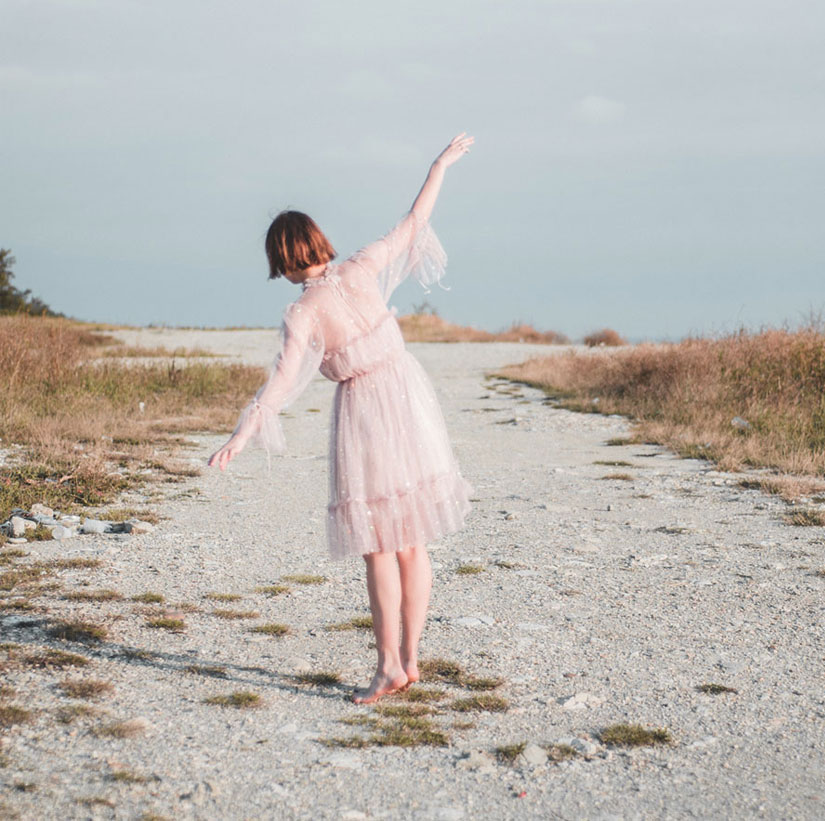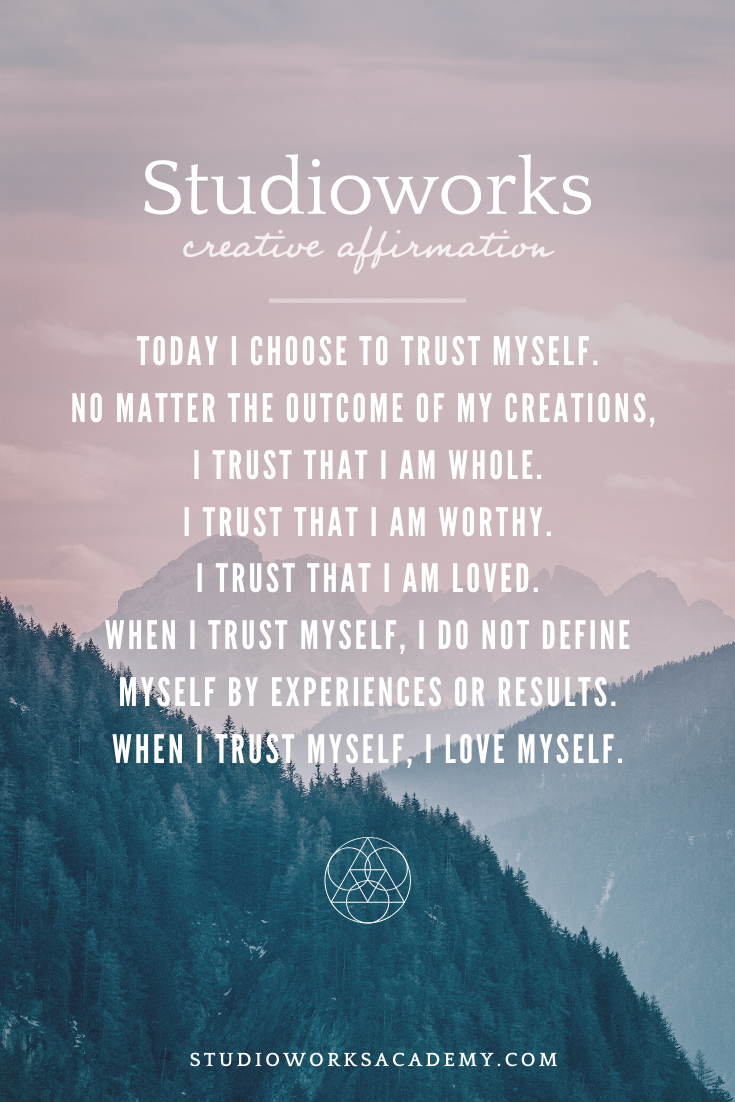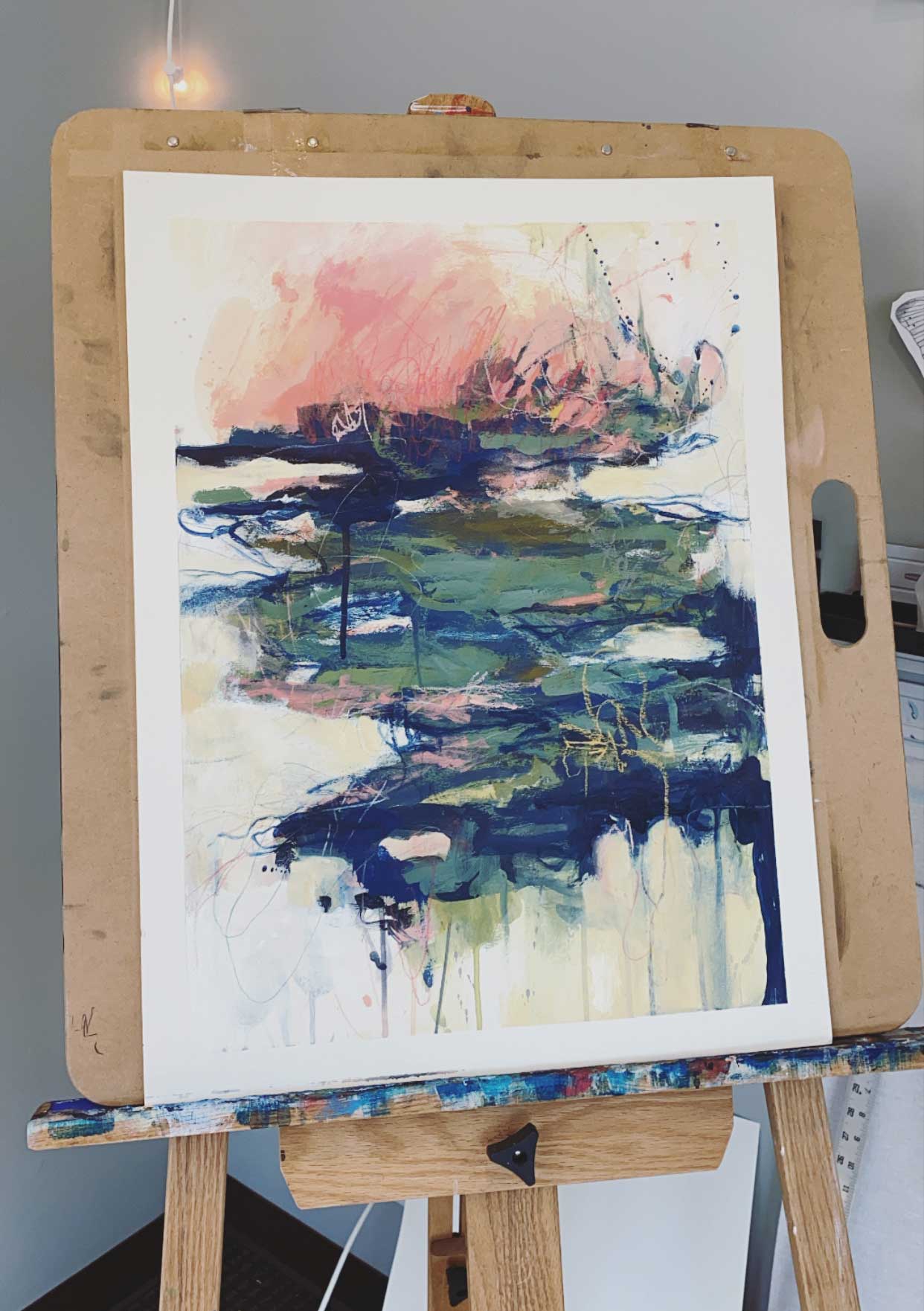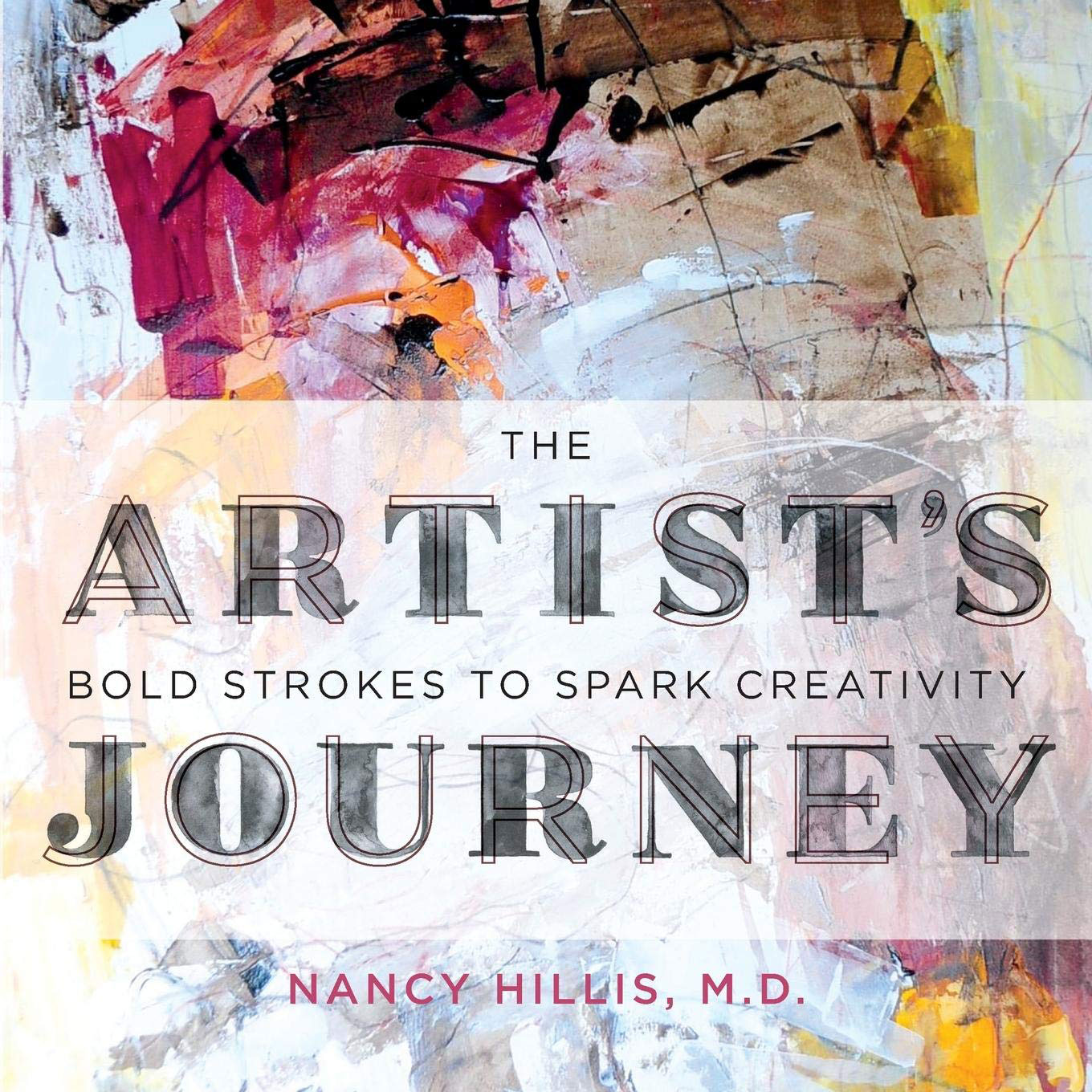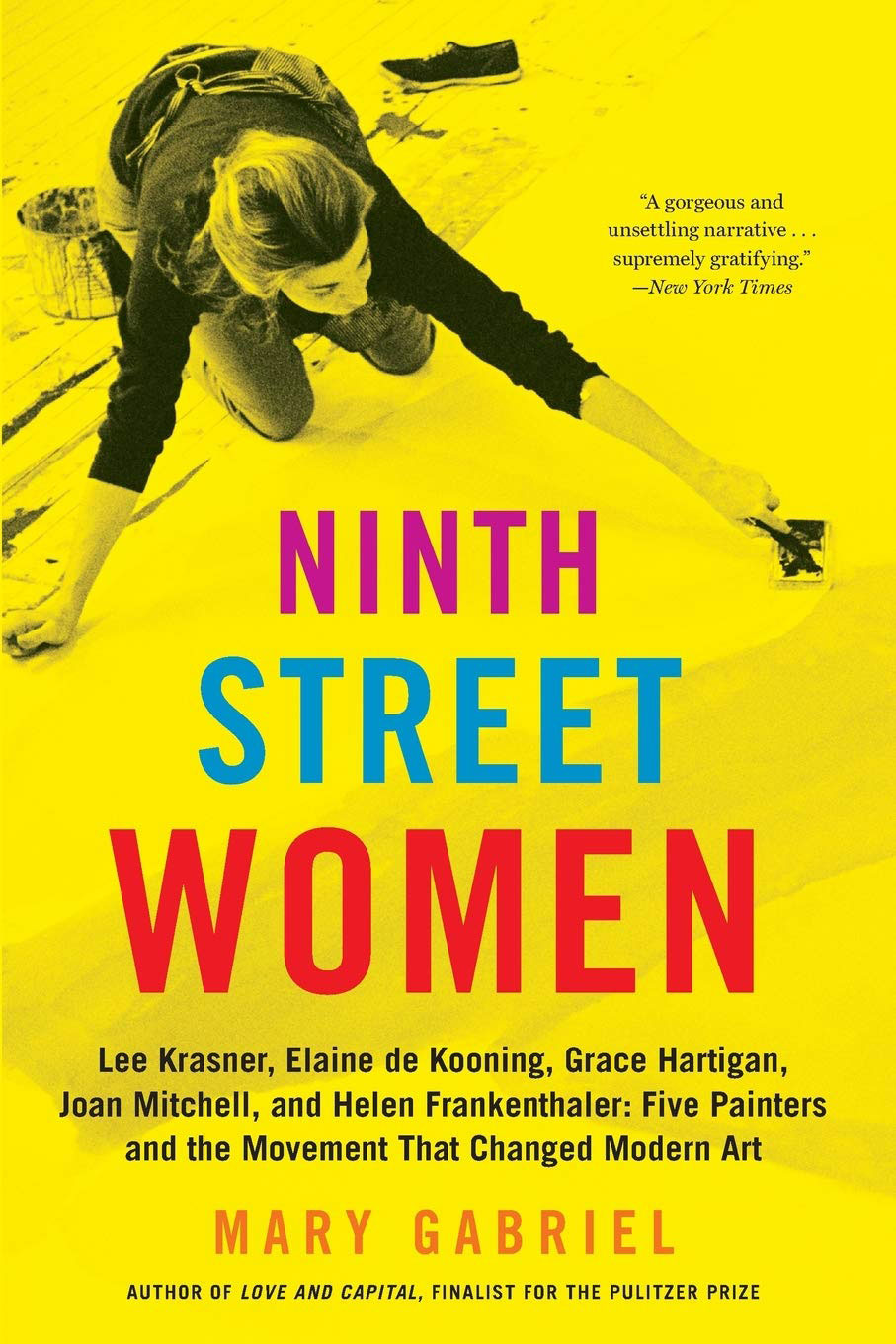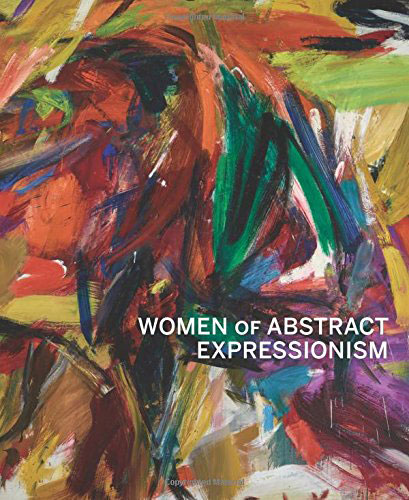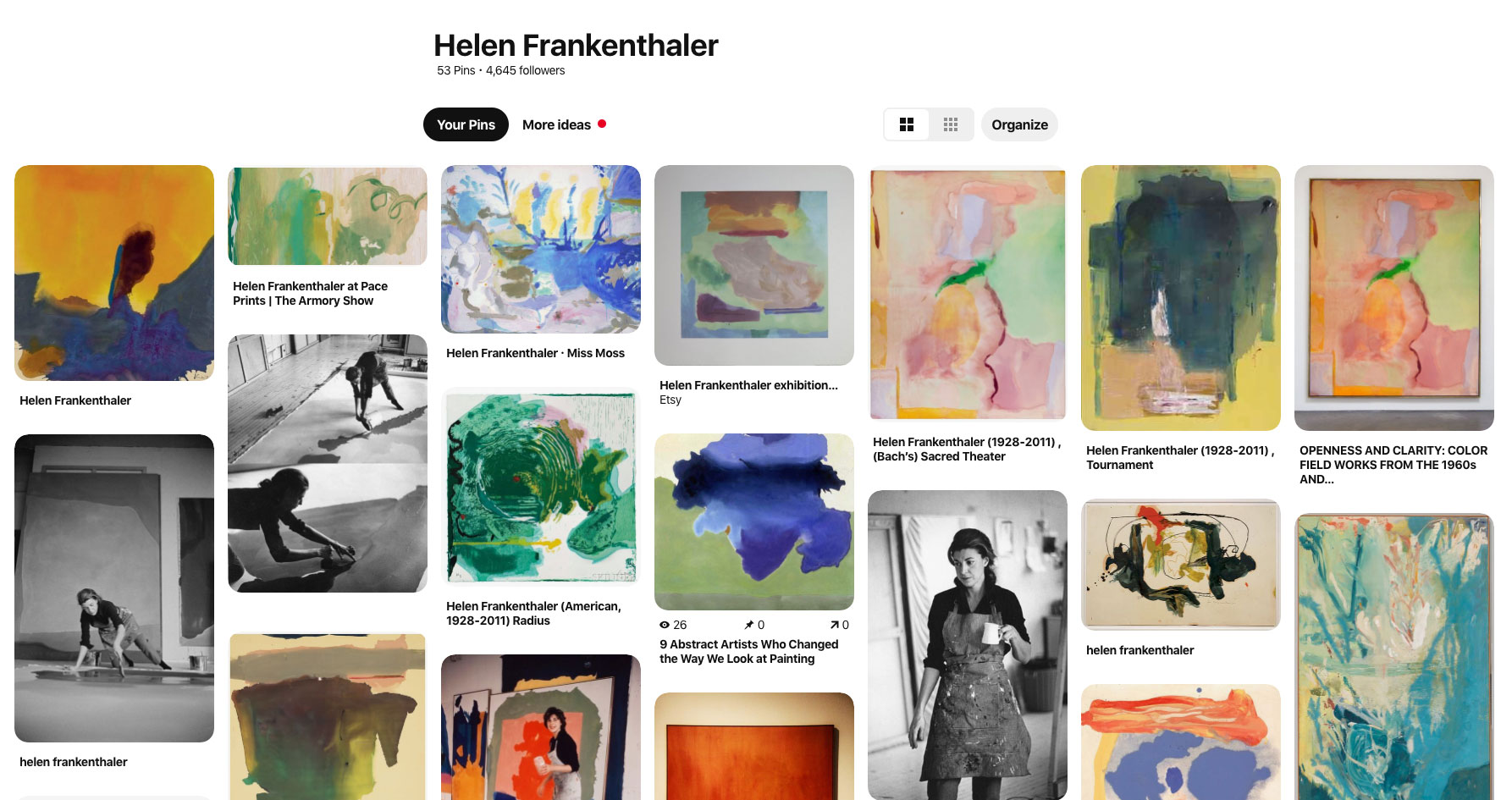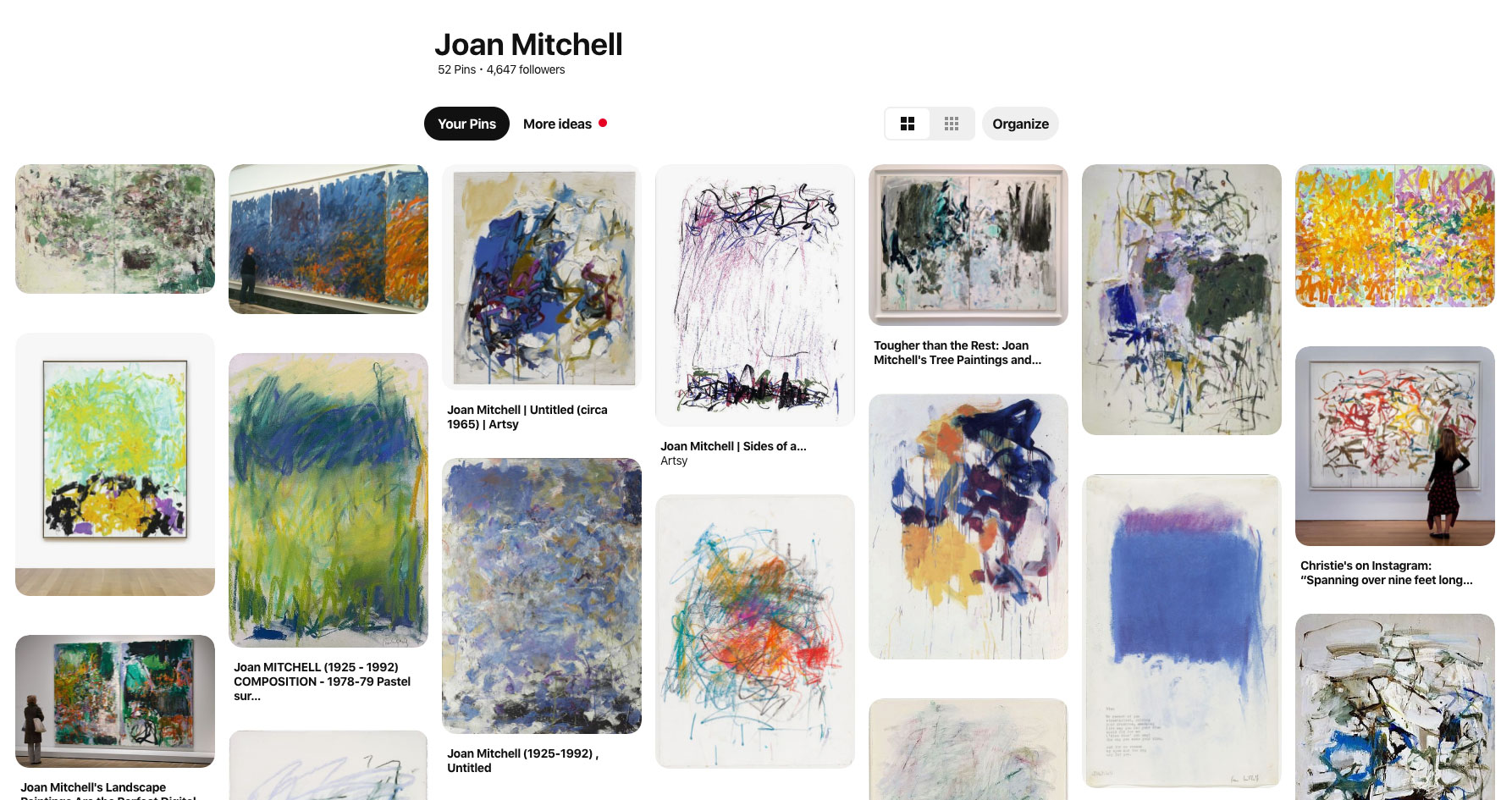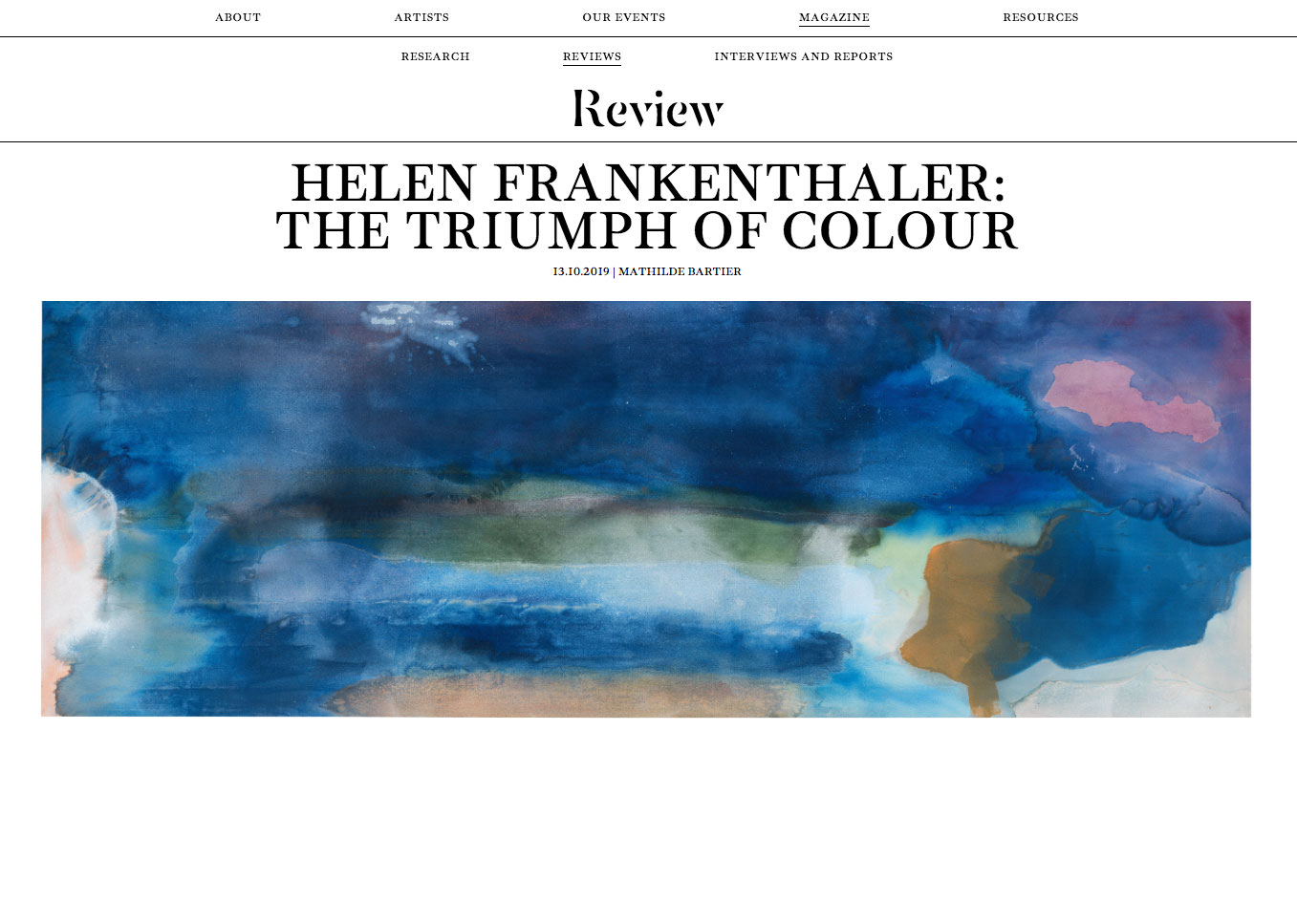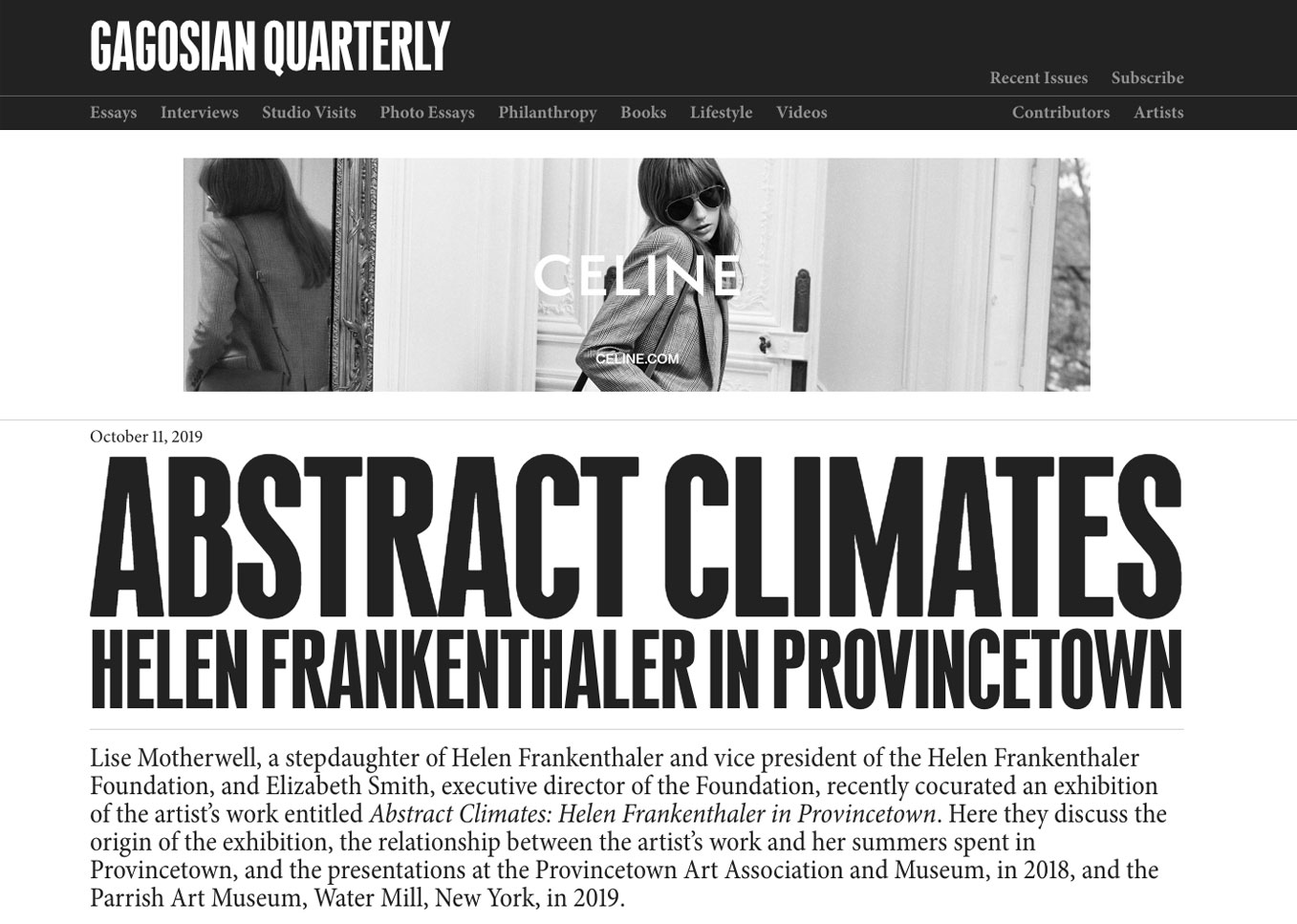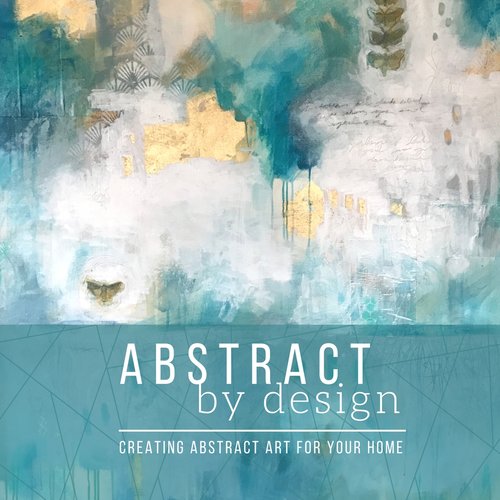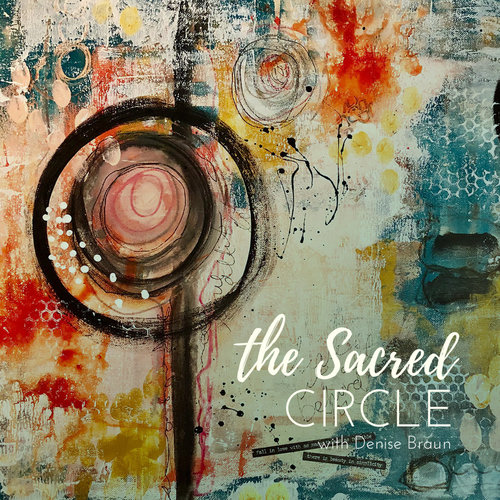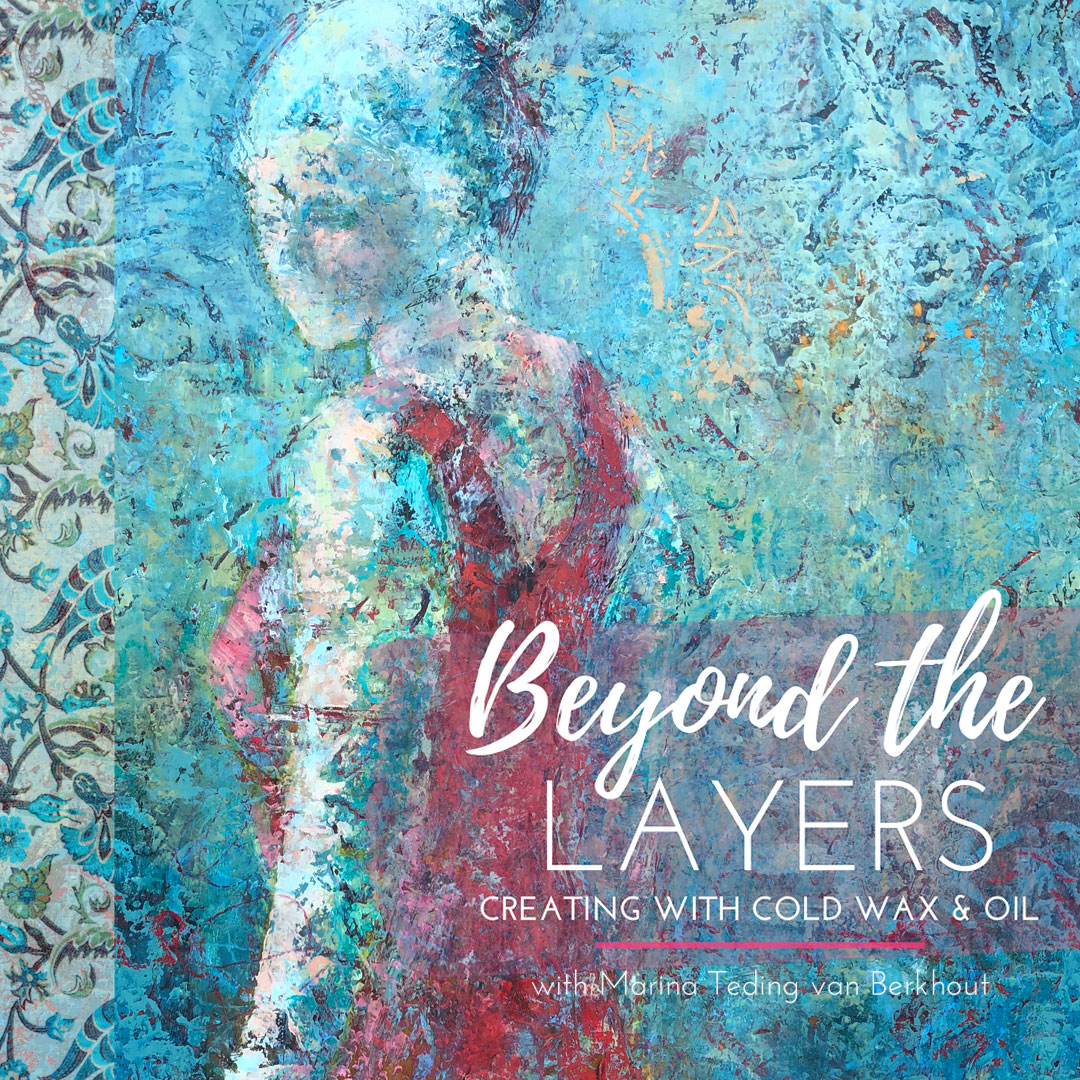IVY NEWPORT
Studioworks
Journal
a letter from ivy
Dear creative friends,
Welcome to Issue #15 of the StudioWorks Journal! As always, I’m super grateful you are here with me and I’m excited to share this with you. This month, I wanted us to explore the topic of trust in our creative process. As artists, it is imperative that we cultivate self-trust. Not an easy feat by any means but one worth pursuing. Art invites us into a world of possibility and unknowing – this is both thrilling and terrifying…this is where trusting ourselves comes in.
Let’s look at how we can begin to strengthen this aspect of our artistic journey.
xo,

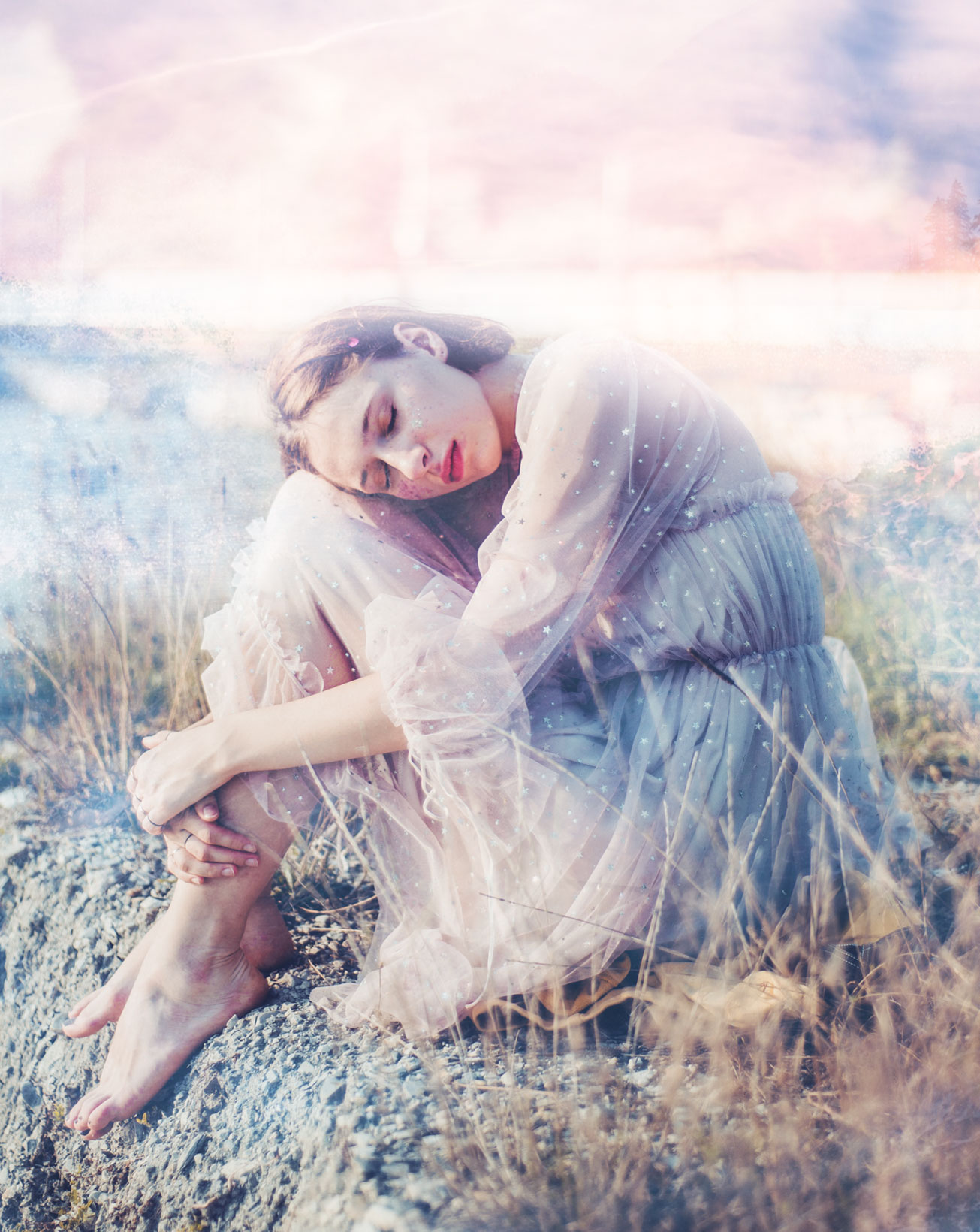
So you may be wondering, where do I start? To that, I say, wherever feels right to you. Each month we will have a theme, a creative affirmation, a power word, a color palette, sketchbook exercises, art projects, articles, recommended reading and access to wonderful inspiration and resources. I want you to think of this as a delicious new magazine, you know the ones you occasionally splurge on, with soft, velvety pages, beautiful images
Each issue will invite you to explore your creative practice in whichever way works for you. Experience each issue at your own pace. Take what resonates with you and put the rest aside for another time.
Grab a cup of something lovely and dive in.
MONTHLY THEME
Trust
Trusting the Way, trusting yourself
“For an artist, the big transformation takes place when you finally learn to trust yourself and give yourself permission to play.”
– Nancy Hillis
The Artist’s Journey
This quote from one of our recommended books truly encapsulates our focus this month. To trust the creative process is to learn to trust yourself. This is when our artistic journey can really open up. All of sudden pathways appear, possibilities arise and our curious, naturally playful muse can emerge!
Self Trust/Self Love
Beginning to cultivate your self-trust takes intention, mindfulness and compassion. It begins with the inner dialog that ensues when we go to create. Pay attention to what you hear when you approach the white canvas – when you step closer to the unknown. When the inner critic begins to wail and undermine your abilities, take a moment and say –
“I trust myself.” Take a step closer, make your first mark with brush or pencil.
Repeat – “I trust myself.”
Make another mark. Turn your music up. Take a deep breath. Dance a little and then repeat – “I trust myself.”
Keep going. No matter how loud the critic gets. Now matter what appears on the canvas.
Trust that you are held.
Trust that you are enough.
Trust that you are creative.
Trust that no matter what happens you are still whole.
Building Trust
Just as trust builds within a friendship or romance, trust can also build within your creative practice. Afterall, trust is essential in healthy, strong relationships right? Well, your creative practice is a RELATIONSHIP with SELF. This is what makes creativity so vital in our lives. It is, at its core, the ultimate unfolding of our inner world. Like a flower unfurling, petals coaxed open with gentle rain and warm sunshine, the same is for your creative self. By taking small steps in trust, by making those first marks on the page, by adding that bold color, by opening that sketchbook…these are all small movements toward trusting yourself. Each one building upon the next. By the time you have completed a painting, you have actually gone through hundreds of moments of trusting yourself. You have navigated yourself through the rough and uncharted waters of creating! So even if you are not happy with the outcome of the final image, celebrate your safe passage…celebrate the treasure that has washed up to your shore, the storm you weathered. These are indeed triumphs!
Don’t like that painting? Okay, put it aside. Go on another voyage. Learn from your last journey. What can you do differently? Where did you go off course? Gather your courage and trust that you will find the shore once again. It is in this place of faith-filled unknowing, where trust thrives, where tiny seeds are planted, each taking root in your heart, each blooming in love.
The more often we step into the mystery and emerge whole, the more often we begin to understand that we can indeed trust ourselves. We become more open, more playful, more compassionate and yes, more CREATIVE! So as you spent time building your creative practice know that you are in turn building your self-trust.
“Trust is built in very small moments”
– Brene Brown
Trust - Trusting the Way, trusting yourself.
TRUST AND TRUTH
“Trust is the first step to love.”
– Munshi Premchand
Trust always begins in truth. So, what lies have you been telling yourself? Maybe some of these sound familiar? Let me counteract them with some TRUTHS so we can start to rework what we are saying to ourselves…over and over and over….
LIE # 1 – “I’m not creative.”
TRUTH – If you are alive, you are creative. Every human being is creative. That’s a fact. It’s your job to figure out how to use your creativity in a way that brings happiness, growth and joy into your life. So quit saying this to yourself.
LIE # 2 – “I’m not good enough.”
TRUTH – There is NO prerequisite to engage in your creativity. You don’t need a degree, a certain number of hours or a certificate to create something. You don’t even need to be “good”! LOL. If you have the desire to paint, draw, sculpt, write, sing, dance, cook. You have a RIGHT to do it! If you love enough, you will want to get better at it – so…great….do that!
LIE # 3 – “I’m a perfectionist.”
TRUTH – No, you are scared and that’s ok. Perfectionism is just another way for your fear to stop you from trying something new. We intellectually know that perfect doesn’t even exist and at best is incredibly subjective…so yeah…I’m afraid this is a big fat lie. You may like things “perfect” but while staying in that box what are you missing out on?
LIE # 4 – “I’m not as good as (fill in person’s name here)”
TRUTH – Ok…so maybe you aren’t. Who cares? Have you put in as much time in practice as this person. Do you show up and consistently do the work like this person has? Let’s face it, there will ALWAYS be someone “better” than you BUT this is completely irrelevant to your own creative journey. So accept where YOU are and proceed accordingly. If you spend your time worrying about how “good” everyone else is you are just wasting energy that could be redirected into your own practice.
LIE # 5 – “I’m totally creatively blocked.
TRUTH – Ok, so we all tell ourselves this one and in some ways it is true and absolutely normal but let’s re-work this a bit. Often we are blocked after we have just expended a lot of creative energy. In this case, we are just tired! We are cyclic beings and a rest period only makes sense. So, let yourself be quiet and still and refill. Trust that this WILL happen.
Other times, we tell ourselves we are blocked after we have suffered a creative injury, like being criticized, or rejected or perhaps we feel we failed in some way. In this case, you are wounded, so honor that and allow yourself space to heal. Create small pieces in the safety of your sketchbook or let yourself doodle, or color swatch. Watch movies you love and read books that absorb your imagination. In time, you will heal and inspiration will return – IF – and this is important – IF YOU STOP TELLING YOURSELF YOU ARE BLOCKED ALL THE TIME! Focusing on this thought will keep you blocked.
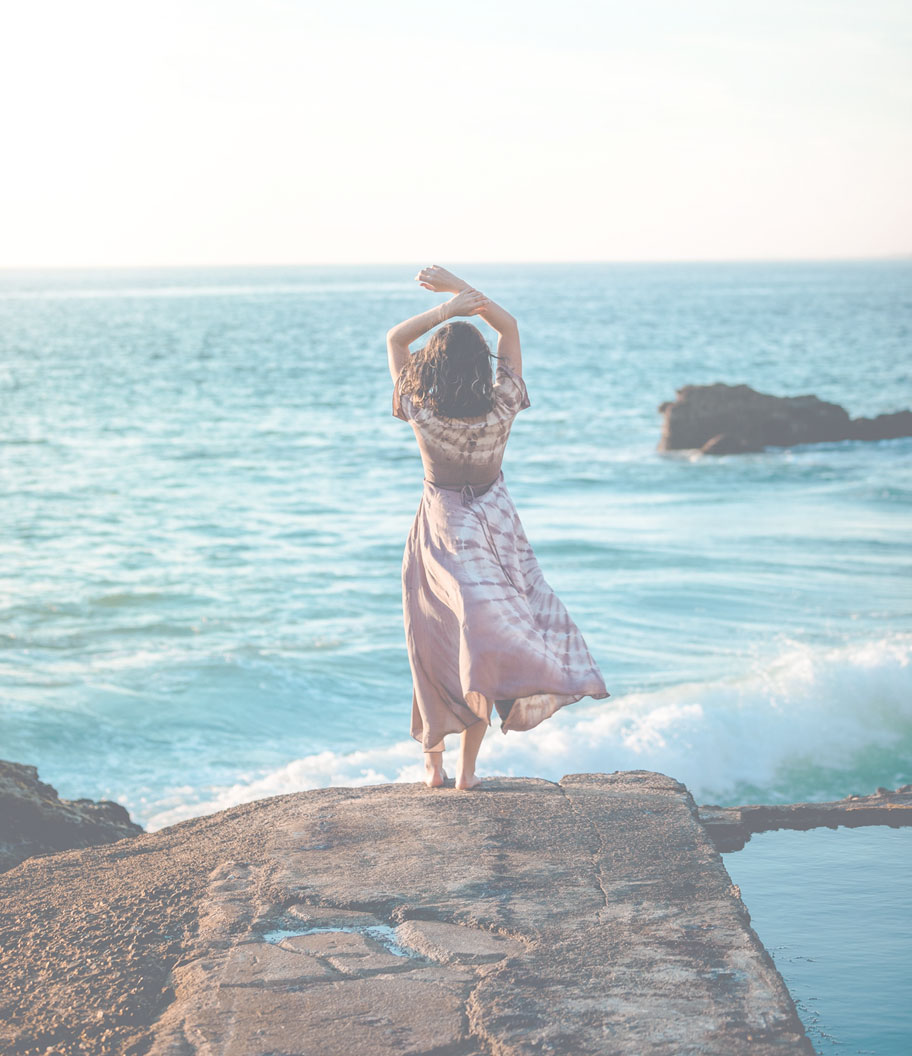
Remember, your thoughts manifest your reality, so be mindful of what you are telling yourself, be careful what story you are weaving about your life and your creativity. Only you can control your inner dialogue. Change the language, focus on truth and compassion and your trust in yourself will grow.
Trust when things go sideways
So we all know that moment when our artwork goes sideways. Everything suddenly looks awful. You feel like you’ve lost control of the work. It feels awkward, amateurish and worse still…ugly! Yikes! Suddenly, your inner critic is blasting you with harsh judgements and seething reproaches. Ugh.
So where does trust come into the fold when this happens? Well…here’s the thing, trusting yourself isn’t about you ALWAYS making the right move or consistently choosing the right path. On the contrary, art making is often a winding, rollercoaster of a ride with many unseen bends and dips. Trusting yourself – is staying in the moment. Trusting yourself is like a seatbelt. It holds you securely in place, rooted to yourself, to the core of your being. Trusting yourself is the loving act of knowing, deeply knowing, that NO matter the outcome of your creation – that you are whole and you are worthy. It is trusting that your mistakes are not who you are but rather external experiences along the way.
Trusting yourself is knowing that at the end of the harrowing adventure, you will rise and carry on.
Trust and Truth
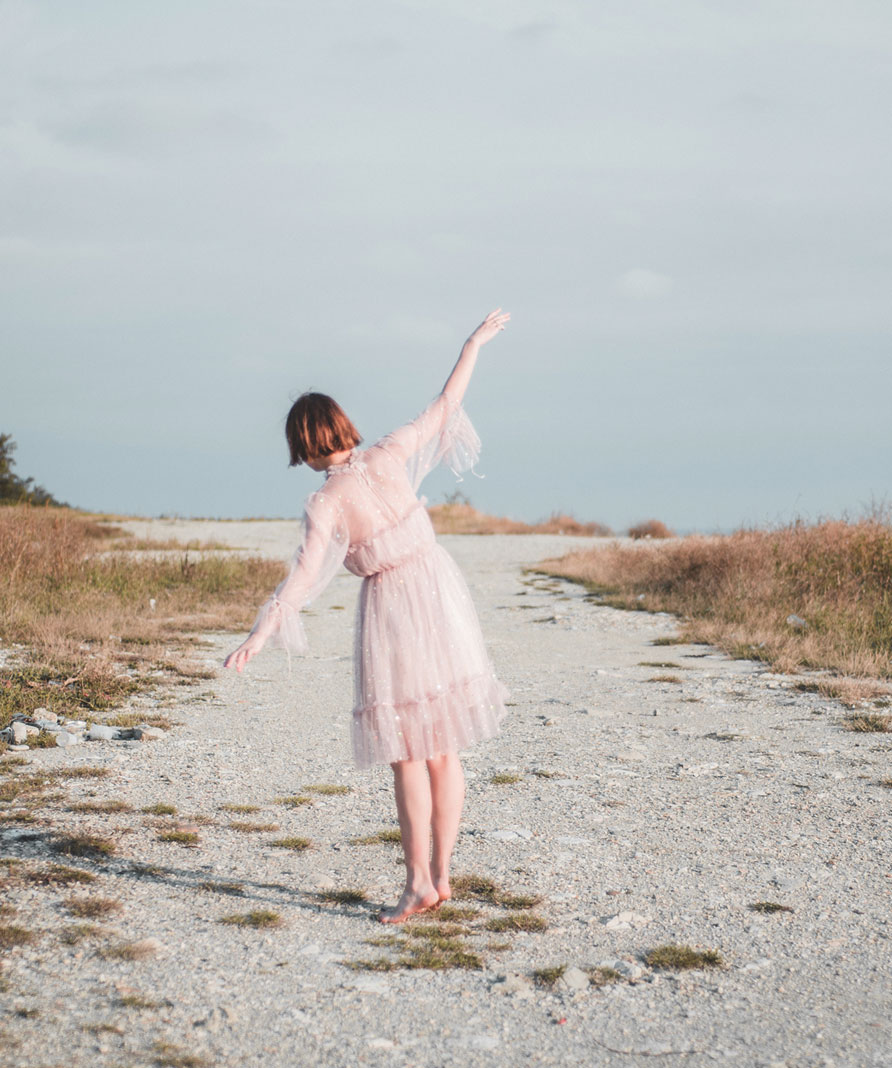
“Remember, there are no mistakes, only lessons. Love yourself, trust your choices and everything is possible.”
– Cherie-Carter Scotts
TRUST YOURSELF PROMPT:
- Make a list of all the people in your life that trust you. Now make a list of WHY they trust you. So….if they trust you…why don’t you trust yourself? Journal about this for a bit. Be honest but loving toward yourself. What past mistakes are you holding on to that you need to forgive yourself for.
WORD OF THE MONTH
Trust
To believe in the reliability, truth, ability, or strength of.
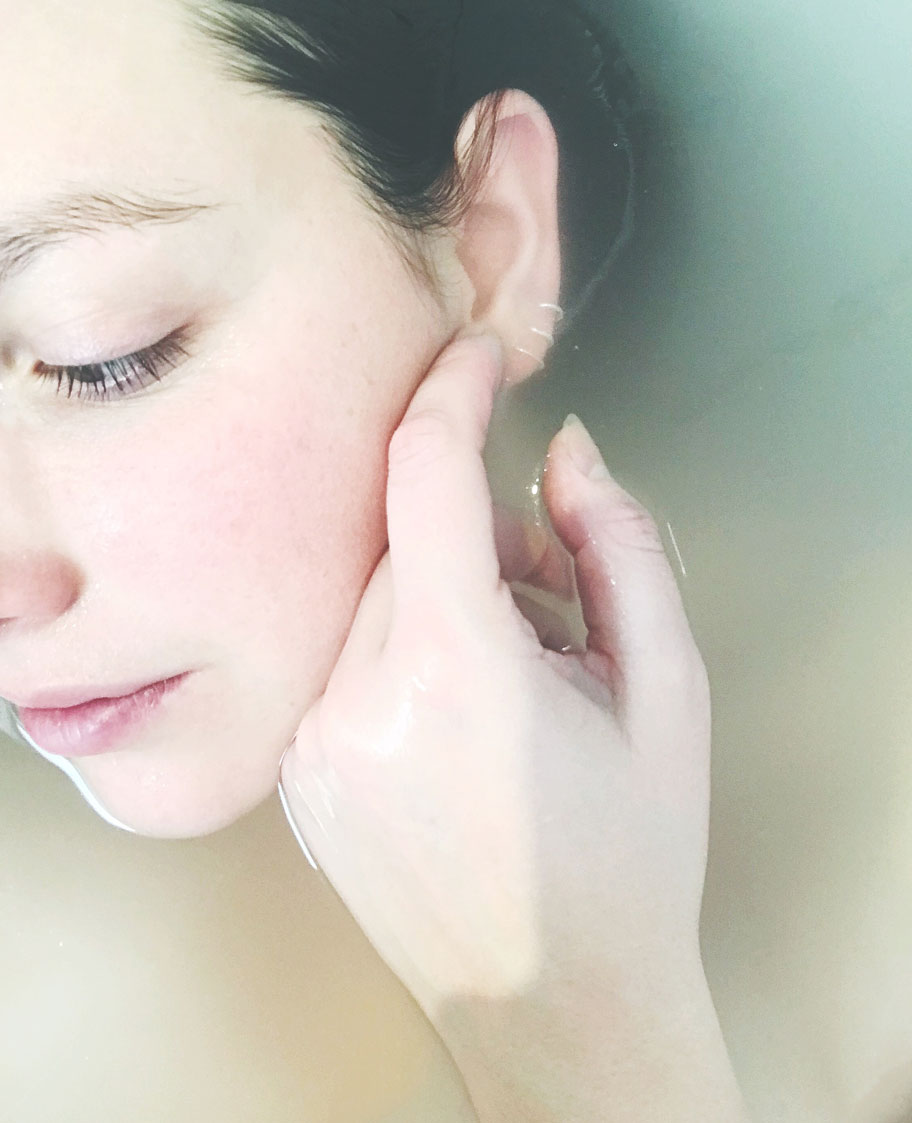
When we think of trust we so often consider our external relationships, our partner, our friends…but what about ourselves? Do you trust yourself? If we don’t we often live in a great amount of fear and doubt. This of course, affects our creativity. If creativity is all about risks…and we have no trust in ourselves, then how can we make the leap? And if we do, how do we do it with love and faith in ourselves? So many times, we take the risk only to berate ourselves when things go awry. We quantify our self worth to our performance. To the outcome.
When we think of trust, we often think of loyalty. So, I ask you, are you loyal to yourself? When you promise to be gentle to yourself when creating, do you keep that promise? When you commit to not compare yourself to others, do you put a stop to the endless scroll on social media where your inner critic spends time seeing if you really measure up? Be aware of these things. Our relationship with ourselves is the most vital relationship in our life.
Believe in the truth, ability and strength of who you are. Trust yourself. Only then can you grow.
“As soon as you trust yourself, you will know how to live.”
– Johann Wolfgang von Goethe
Self Love Meditation
As we have discussed, Self Trust and Self Love go hand in hand so please enjoy this soothing, comforting meditation to help realign yourself with the truth of who you are and the abundant love at your center.
“Talk to yourself like someone you love”
― Brene Brown
Trusting the Process and Getting Unstuck
We can all relate to the idea that we need to trust the process of art making. The unknowing, the exploring, the vulnerability, the uncertainty, the breakthroughs, the wrong turns, the moments of brilliance…it’s a complex and mysterious process to engage in right? Hell yes it is! And try as we might, we can’t avoid those moments when panic surges through us and we wonder – “What the heck am I going to do now?”
It’s called getting stuck. It almost always happens, even if it’s brief. We stare at the canvas completely perplexed, like someone just snatched the map out of our hands!
It’s frustrating, scary and well… just not fun. It’s usually the perfect opportunity for your inner critic to rear it’s ugly head.
So what should we do instead of melting down? Here is a list of 10 ideas to help you get Unstuck while staying in alignment with trusting yourself.
1 . Take a photo.
Often seeing your work through the lens of your phone camera can give you fresh perspective on your piece. While you are at it, convert it to black and white so you can see the balance of values. Squint your eyes a bit and watch where your eye goes first. Make sure that is your focal point. If not, you might need to adjust your values or composition or both.
2. Take a 10-20 minutes break.
Go grab a cup of coffee or tea. Sit and meditate or go for a walk. Sometimes, we just simply need to rest a bit and come back with fresh eyes.
3. Turn your piece upside down.
This is similar to the camera trick. It helps you see the composition and balance in a new way. Again squint your eyes and TRUST your eye… if something is bothering it address it.
4. Work on a different piece.
I often have multiple pieces in process. This switches up your energy and gets you moving…often times you will figure out an idea for the stuck piece while working on something else.
5. Journal about it for a minute.
Sometimes just writing and venting about what is frustrating about the piece can release energy and get you on with things.
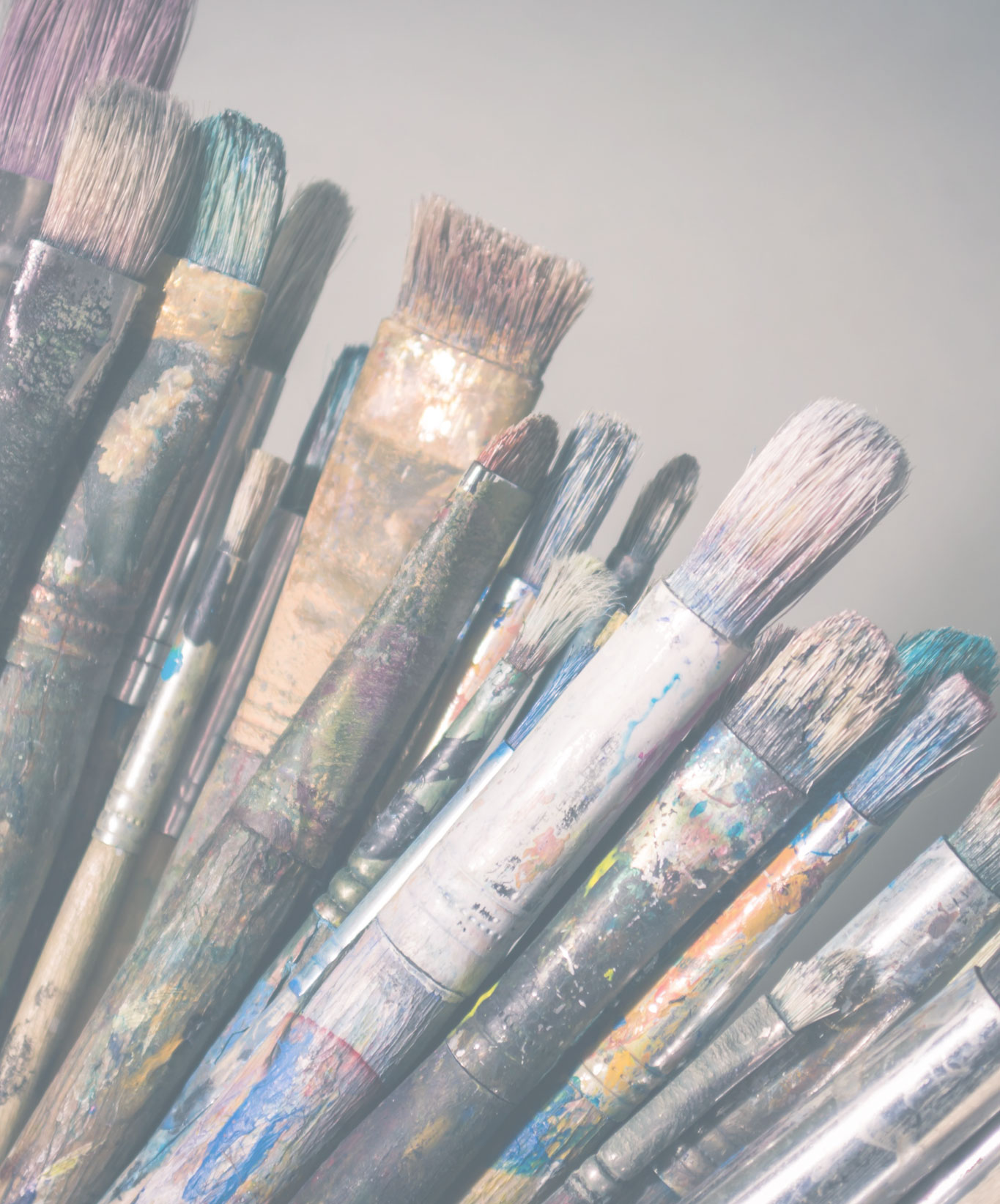
6. Ask for criticism.
Ask for constructive criticism from a trusted fellow artist or in a safe Facebook group (like ours) getting ideas from others can be wonderful and help you learn how to take feedback. Only act on the feedback that feels right to you but be open to trying something you hadn’t thought of.
7. Play some music and dance!
Work out that frustrated, stuck energy by moving your body. This can energize you and shift you to focusing on your intuition rather than your logic. Listen to your body….it will have different ideas than your mind.
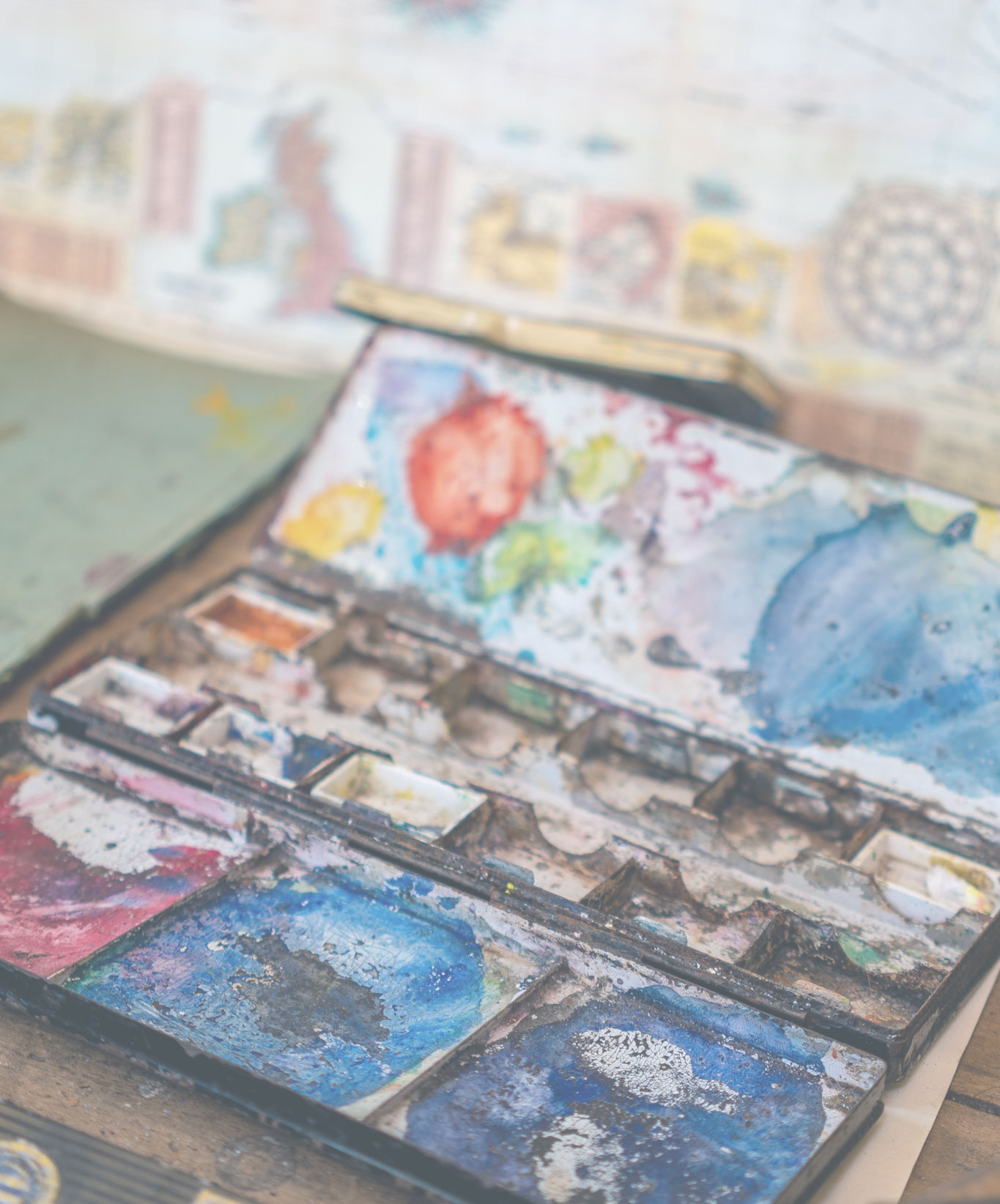
8. Do something mundane.
Go wash the dishes or unload the dishwasher. Go vacuum a room or take a shower. This kind of activity allows the mind to wander and your imagination to awaken. Don’t be surprised if ideas emerge!
9. Explore ideas digitally.
Take a photo of your work and then important it into an app like Procreate or a program like Photoshop….experiment on the piece in a digital world where mistakes can be easily corrected. This often sparks ideas for me!
10. Sleep on it.
Give this “stuck” piece a breather. Hang it on the wall where you will regularly see it and then give it some space.
“Trust yourself, you know more than you think you do.”
– Benjamin Spock
Trusting the Process and Getting Unstuck
Monthly Affirmation
Each month we will have a positive affirmation. I recommend you print out this affirmation and put it in your sketchbook or somewhere in your studio. Recite the affirmation out loud each time you show up to create. Saying words aloud is powerful and can begin to re-write some of our own limiting beliefs or calm our fears. Try it now…
Color Palette of the Month
This month, as we focus on self trust, I couldn’t help but envision soft colors, whispering hues of soft grays, blues, pinks, soft moss green and shades of white. The voice of our true self is often a quiet one, as we know, so these are the colors that, to me, it speaks in. Our intuition guides us gently, pulling at our hand, fluttering in our bellies, tingling on our skin – so these tones resonate with the energy of my self trust and self-love.
I do encourage you to work with a palette that feels in alignment to your own self trust! Trust what colors you are drawn to and really explore them!

“The soul becomes dyed with the color of its thoughts.”
– Marcus Aurelius
Color Palette
TRUST PROMPT:
- Close your eyes and doodle a line on your page. Don’t worry about the outcome. Now open your eyes and see what you see…let your imagination wander. Be playful and make your lines into something. What appears?
MASTER ARTIST GUIDE
Helen Frankenthaler
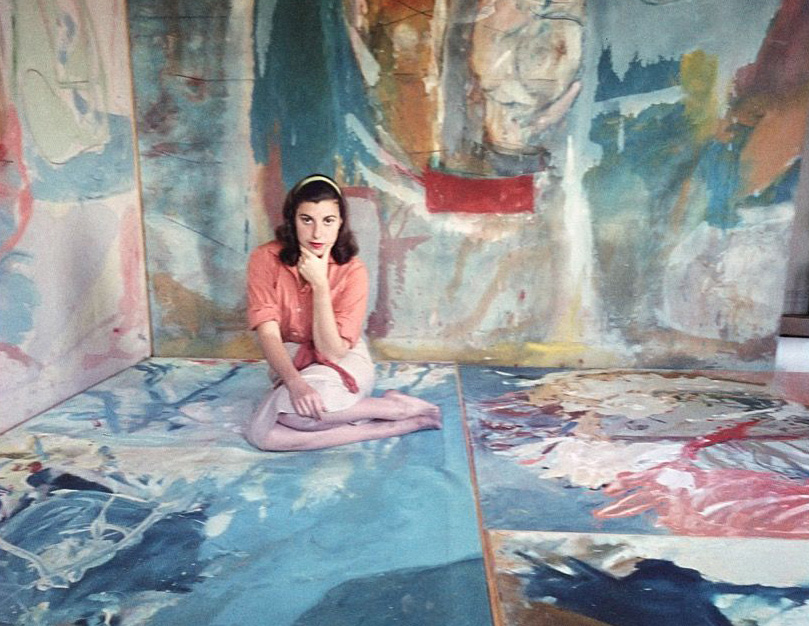
Ok my friends, let’s take a little journey into Abstract Expressionism! Look, I get it…Abstract art isn’t for everyone. It can be a wee bit…well….abstract…but I invite you to put aside your thoughts about it for a minute and open your mind to these amazing artists. Yes plural, I have TWO artists for us to study this month – Helen Frankenthaler and Joan Mitchell.
You may ask why we are focusing on Abstract art? Well, I firmly believe that to create Abstract art, one has to fully embrace the unknown and yes…trust! Abstract art encourages us to really step off the edge into places where we respond to rather than control the process. It is conversation with color, form, space, line and emotion without rational or recognizable elements. Abstract art making confronts us with it’s undefinable nature, forcing us to surrender to the mystery that lies within.
Also, I must note that although you may not resonate with some of these works, realize that abstract painters like the two we are going to study moved artistic expression forward. Through their courageous risks, experiments and explorations, Abstract Expressionists brought to light a freedom in art that was not yet realized. A beauty and rawness that gave birth to a movement that flourishes and evolves today. For this I am grateful.
LET’S LEARN A LITTLE MORE ABOUT HELEN:
Helen Frankenthaler greatly influenced the abstract expressionist movement in America during the Postwar period and left an incredible impression on modern art as a whole. There is an incredibly spontaneous energy in her work and she embraces the beauty of nature in the simplicity of form, color and space. There is a sense of freedom and exploration in her pieces that inspires risk taking, play and experimentation. It is art for the sake of art. For the sake of creating. Art that doesn’t ask for definitions or inherent limitations or rules but rather invites you into a world of possibility.
Through her brushstrokes and pools of color, one can sense that she deeply trusted both herself and the process of artmaking. You don’t sense hesitation in her marks nor do you see an overworking of the nascent, childlike energy that emerges when we create. There is much to learn from abstract expressionists, EVEN if your goal is to be a portrait artist or a landscape painter. Study their work and understand that many of these artists harness the raw, potent and unedited energy of pure creativity. To understand how to respect and honor and TRUST this energy is key to any artist.
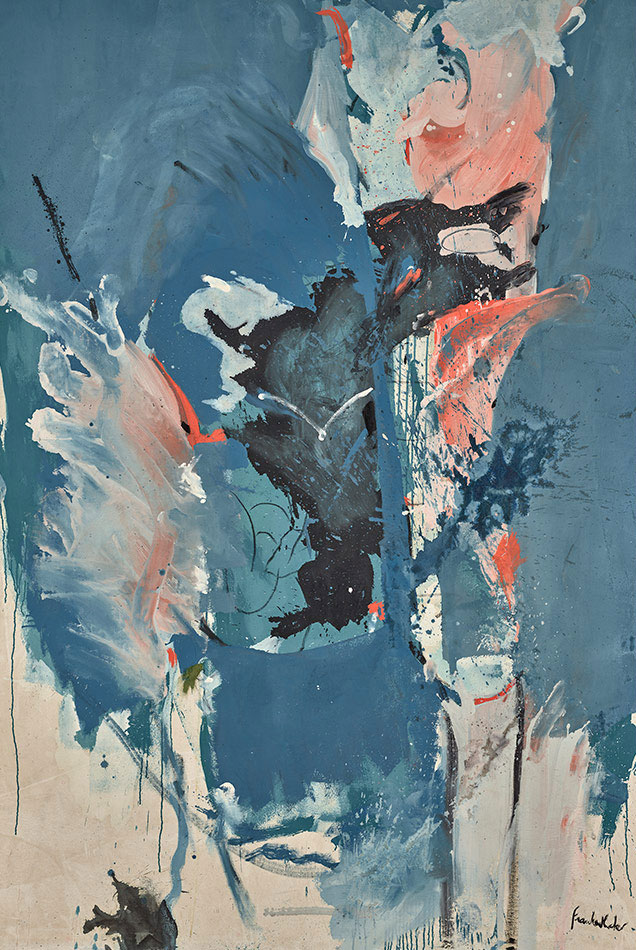
Sea Picture with Black (1959)
“There are no rules. That is how art is born, how breakthroughs happen. Go against the rules or ignore the rules. That is what invention is about.“
– Helen Frankenthaler
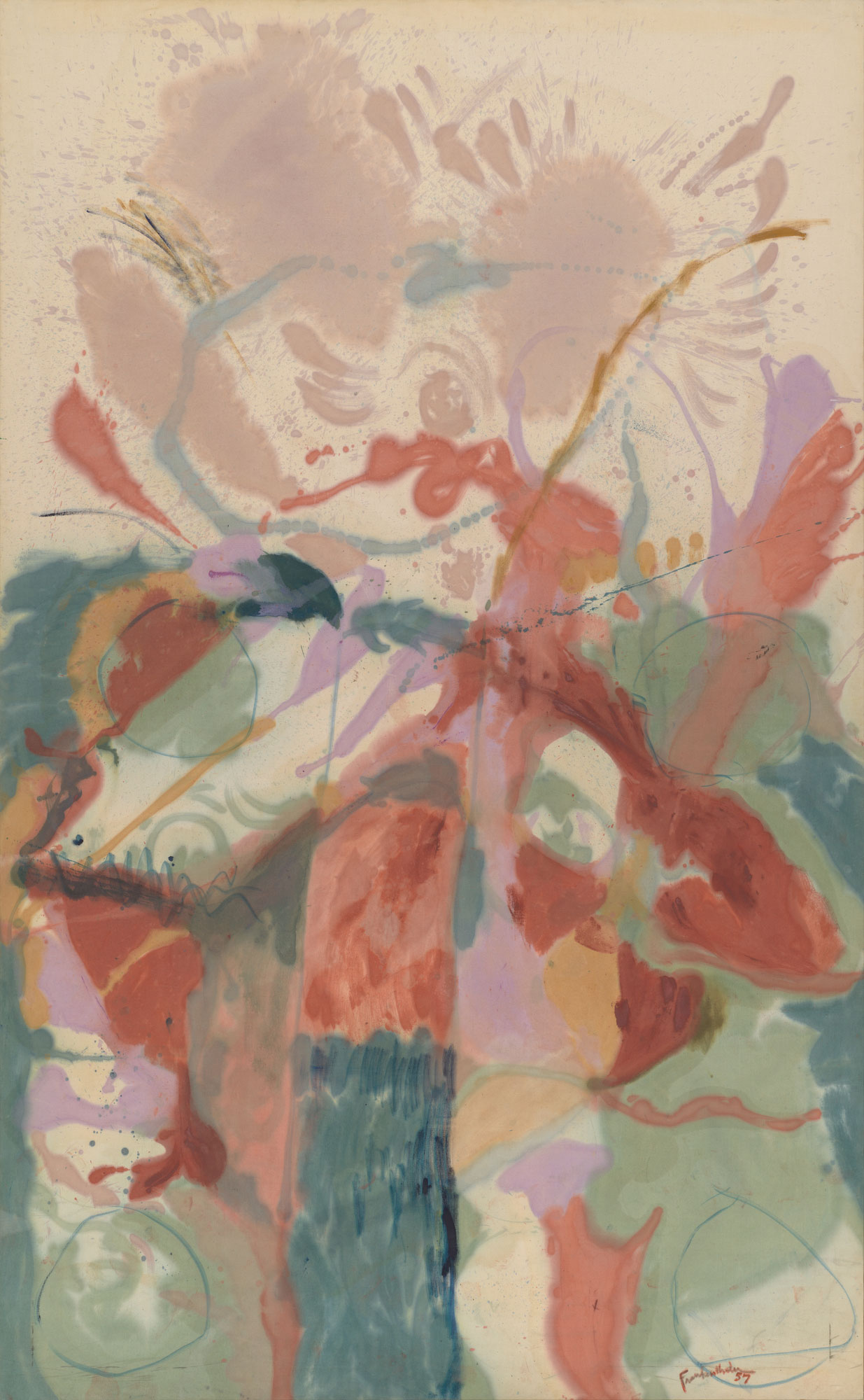
Jacob’s Ladder (1957)
Helen Frankenthaler (1928-2011), whose career spanned six decades, has long been recognized as one of the great American artists of the twentieth century. She was eminent among the second generation of postwar American abstract painters and is widely credited for playing a pivotal role in the transition from Abstract Expressionism to Color Field painting. Through her invention of the soak-stain technique, she expanded the possibilities of abstract painting, while at times referencing figuration and landscape in unique ways. She produced a body of work whose impact on contemporary art has been profound and continues to grow.
Frankenthaler was born on December 12, 1928, and raised in New York City. She attended the Dalton School, where she received her earliest art instruction from Rufino Tamayo. In 1949, she graduated from Bennington College, Vermont, where she was a student of Paul Feeley. She later studied briefly with Hans Hofmann.
Frankenthaler’s professional exhibition career began in 1950, when Adolph Gottlieb selected her painting Beach (1950) for inclusion in the exhibition titled Fifteen Unknowns: Selected by Artists of the Kootz Gallery. Her first solo exhibition was presented in 1951, at New York’s Tibor de Nagy Gallery, and that year she was also included in the landmark exhibition 9th St. Exhibition of Paintings and Sculpture.
In 1952, Frankenthaler created Mountains and Sea, a breakthrough painting of American abstraction for which she poured thinned paint directly onto raw, unprimed canvas laid on the studio floor, working from all sides to create floating fields of translucent color. Mountains and Sea was immediately influential for the artists who formed the Color Field school of painting, notable among them Morris Louis and Kenneth Noland.
She had her first major museum exhibition in 1960, at New York’s Jewish Museum, and her second, in 1969, at the Whitney Museum of American Art, followed by an international tour.
Frankenthaler experimented tirelessly throughout her long career. In addition to producing unique paintings on canvas and paper, she worked in a wide range of media, including ceramics, sculpture, tapestry, and especially printmaking.
Frankenthaler was the recipient of numerous honorary doctorates, honors, and awards. She received the National Medal of Arts in 2001; served on the National Council on the Arts of the National Endowment for the Arts from 1985 to 1992 and was a member of the American Academy of Arts and Letters, 1974–2011). Important works by Frankenthaler may be found in major museums worldwide.
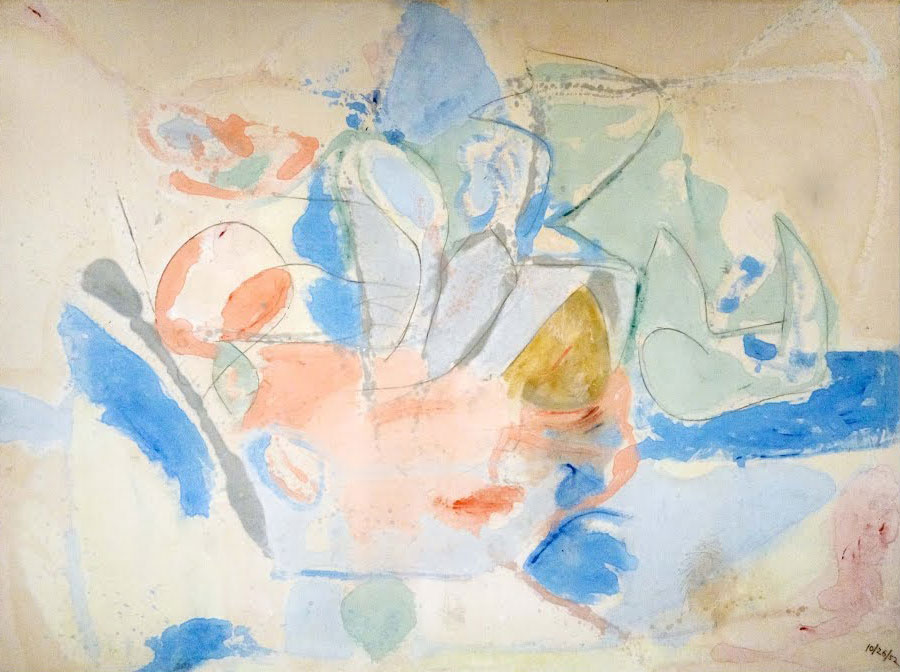
MOUNTAINS AND SEA (1952)
Enjoy this slide show of her work
To learn more about Helen and see her complete works go here:
“A really good picture looks as if it’s happened at once. It’s an immediate image.“
– Helen Frankenthaler
MASTER ARTIST GUIDE
Joan Mitchell (1925 –1992)
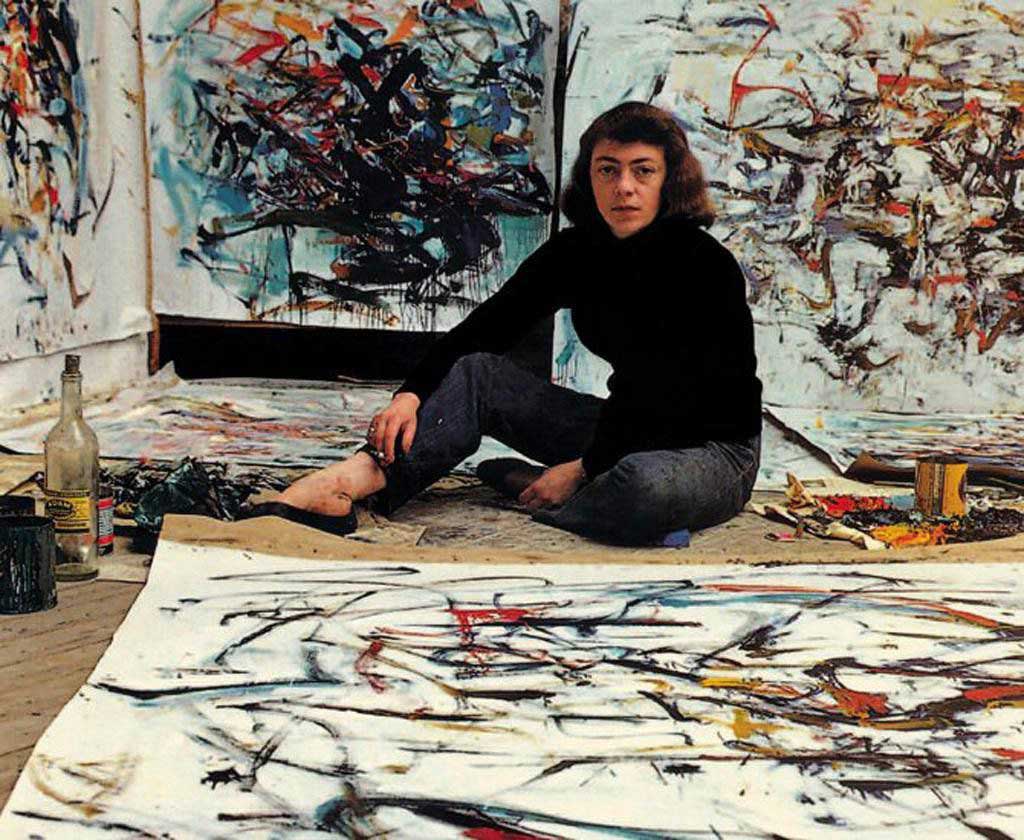
While Helen Frankenthaler and Joan created during the same period and often exhibited together there is a clear difference in their approach to art making. In contrast to Frankenthaler’s spacious, color field work, Joan Mitchell’s paintings vibrate with brushstroke, mark and line. They almost bound to life before your eyes. Slashes of paint alongside delicate lines, watery drips and wandering scribbles, her works are filled to the brim with life. It is no wonder she was defined as an “action painter.” From her strokes, you can feel the pressure she used, the speed of her hand, the intensity of her grip. You can feel her body moving with the paint.
For me, she represents a pure kinesthetic expression of color and line, one which has little to do with logic or forethought. One art critic wrote – “ Her ability to reflect the flow of her consciousness in that of nature, and in paint, is all but unparalleled.” That is an achievement indeed – to channel your flow of consciousness directly to the canvas…don’t we all yearn for this in one way or another? A pure expression unhindered and untouched by the critical mind.
“Painting is the only art form except still photography which is without time. Music takes time to listen to and ends, writing takes time and ends, movies end, ideas and even sculpture take time. Painting does not… It’s a still place. It’s like one word, one image…“
– Joan Mitchell
LET’S LEARN A LITTLE MORE ABOUT JOAN:
Joan Mitchell was born in Chicago in 1925. After graduating from the School of the Art Institute of Chicago in 1947, she was awarded a James Nelson Raymond Foreign Traveling Fellowship, which took her to France for a year in 1948-49, and it was there that her paintings moved toward abstraction. Returning to New York, she participated in the famous “9th Street Show” in 1951, and soon established a reputation as one of the leading younger American Abstract Expressionist painters. She exhibited regularly in New York throughout the next four decades and maintained close friendships with many New York School painters and poets.
In 1955 she began dividing her time between New York and France, and in 1968 she settled in Vétheuil, a small town in the countryside outside of Paris, where she worked continuously until her death in 1992. During the almost 50 years of her painting life, as Abstract Expressionism was eclipsed by successive styles, Mitchell’s commitment to the tenets of gestural abstraction remained firm and uncompromising. Summing up her achievement, Klaus Kertess wrote, “She transformed the gestural painterliness of Abstract Expressionism into a vocabulary so completely her own that it could become ours as well. And her total absorption of the lessons of Matisse and van Gogh led to a mastery of color inseparable from the movement of light and paint.”
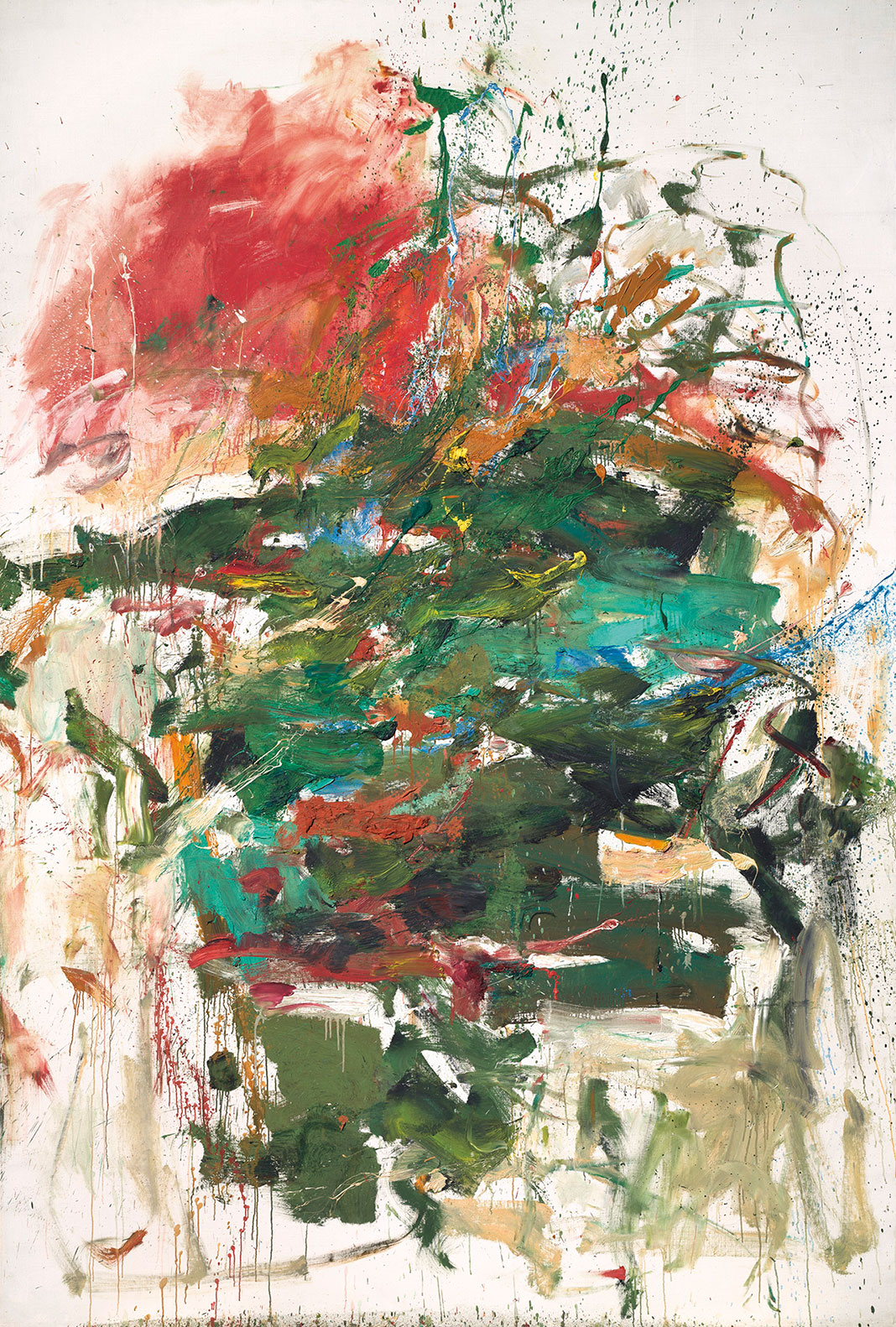
12 HAWKS AT 3 O’CLOCK (1960)
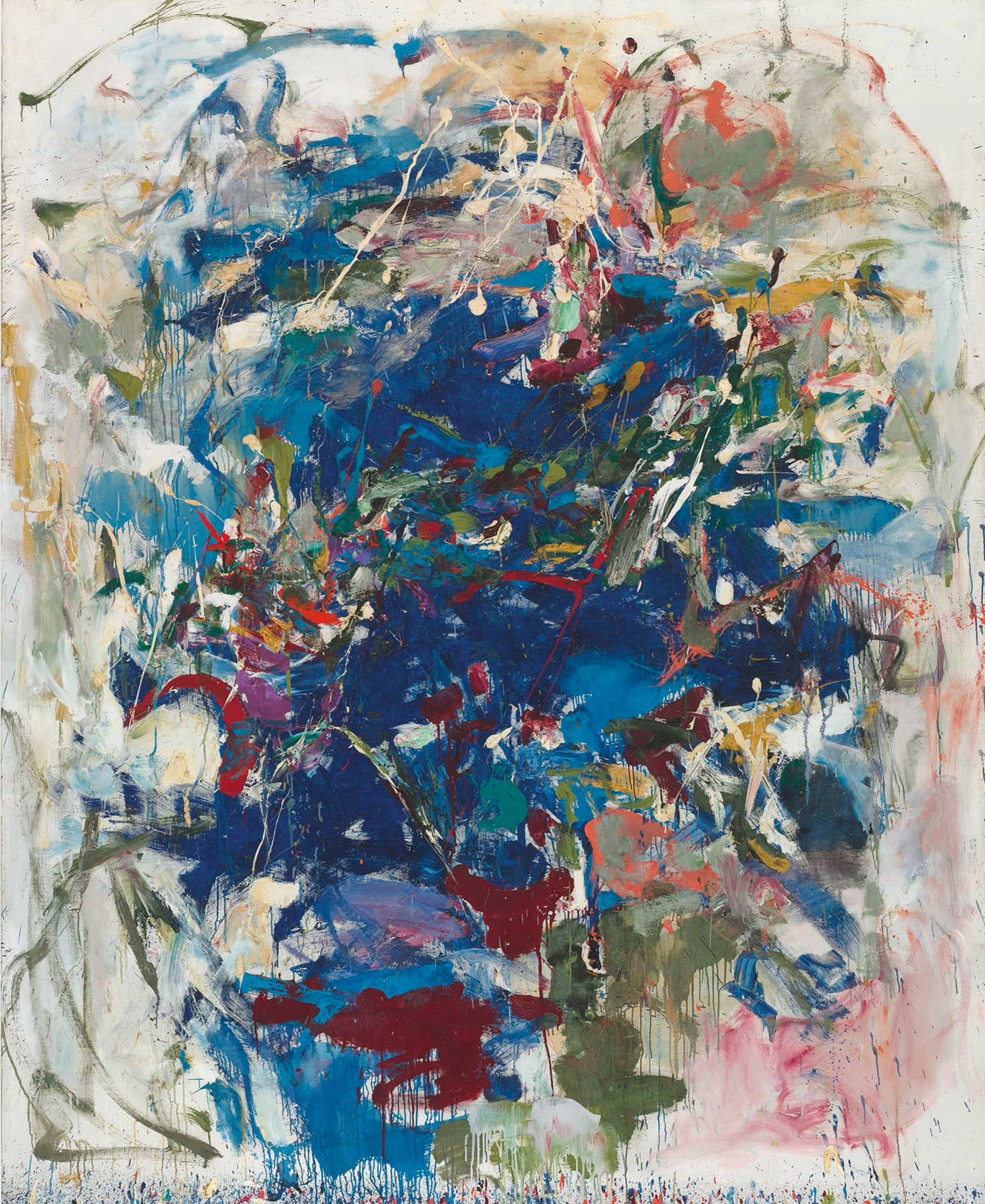
UNTITLED (1960)
Mitchell gave personal support to many young artists who came to stay with her at Vétheuil—sometimes for just one night; sometimes for an entire summer. Correspondence in her papers reveals that this generosity often had a life-changing impact on those that spent time with her. Mitchell died in Paris on October 30, 1992 of lung cancer.
“I paint from remembered landscapes that I carry with me – and remembered feelings of them, which of course become transformed. I could certainly never mirror nature. I would more like to paint what it leaves with me.“
– Joan Mitchell
Enjoy this slide show of her work
To learn more about Joan and see her complete works go here:
Here’s a Pinterest board full of her work to inspire you!
Master Artist Guide
Sketchbook Explorations
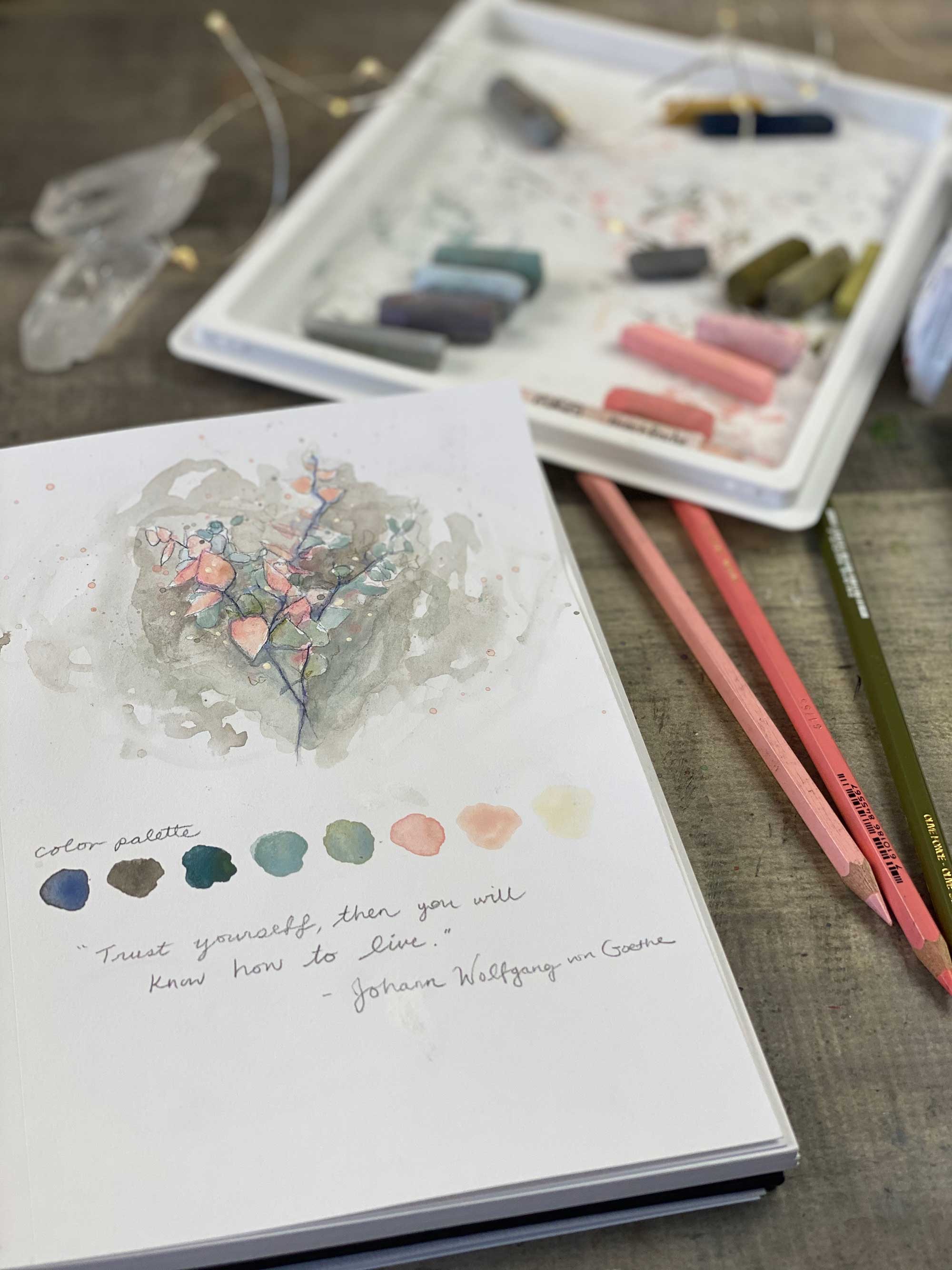
Before we begin our explorations, I wanted to provide a cohesive theme for us to focus on. This will help unify our explorations and provides us with a simple place to start when approaching a VERY blank sketchbook.
Our sketchbook theme this month is Abstraction. Since we are focusing on self trust, it only makes sense that we explore the mysterious unknown landscape of abstraction in our sketchbooks. When we separate ourselves (and our self worth) from the outcome of our creations we deepen our self-trust and self compassion. With Abstract art, it is truly about being open to the discovery, mystery and experimentation that is inherent in this work.
Please remember, our explorations in our sketchbook are really just access points to get you into the flow. However, they can also be seeds for new ideas, concepts and themes in your art. Some of them will be more about writing and others more about drawing and painting. You will see below three prompts and exercises explained and photographed from my own sketchbook. You are welcome to expand upon, invent and experiment with your own concepts too. Use our color palette if you want to. You will see I stay in that theme for my explorations. These may feel silly at first but let your inner artist play.
EXPLORATION 1
Trust Yourself
On a page in your sketchbook write over and over and over with a pencil – “I Trust Myself”. Now begin to add color, marks and layers on top….see what emerges from this exploration. I ended up collaging on a figure and really leaning into the emotional aspect of this exploration. You can use the same image here if you like…
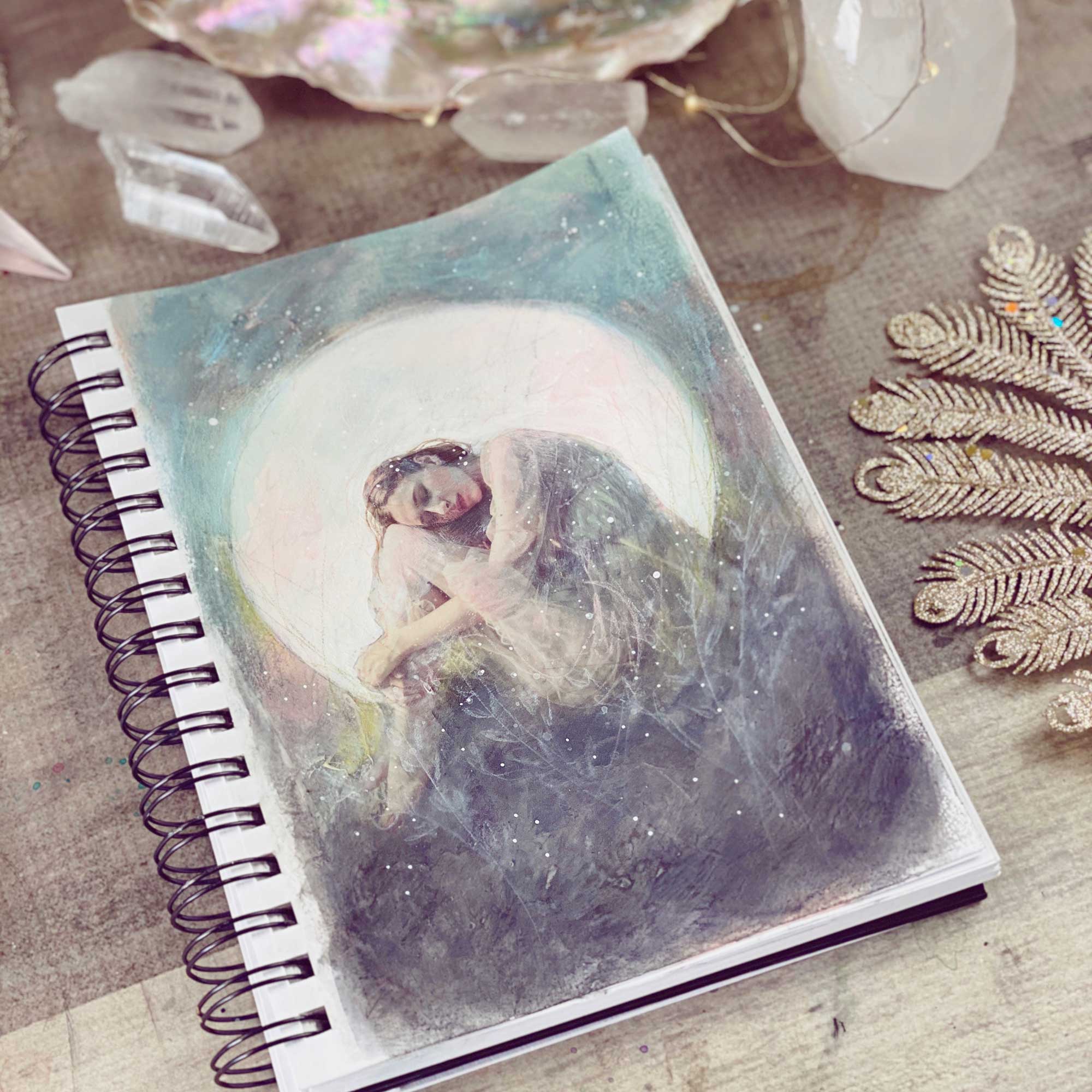
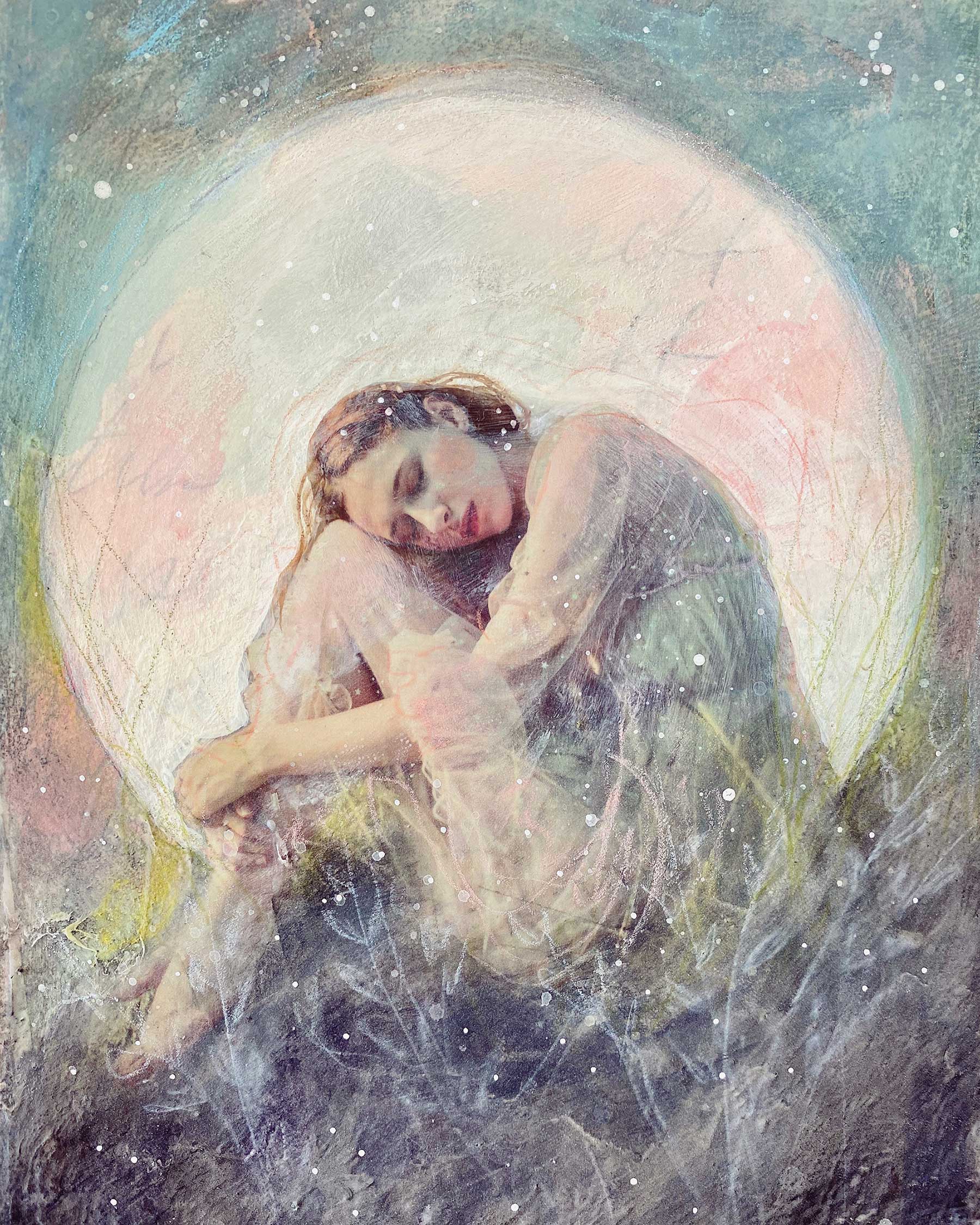
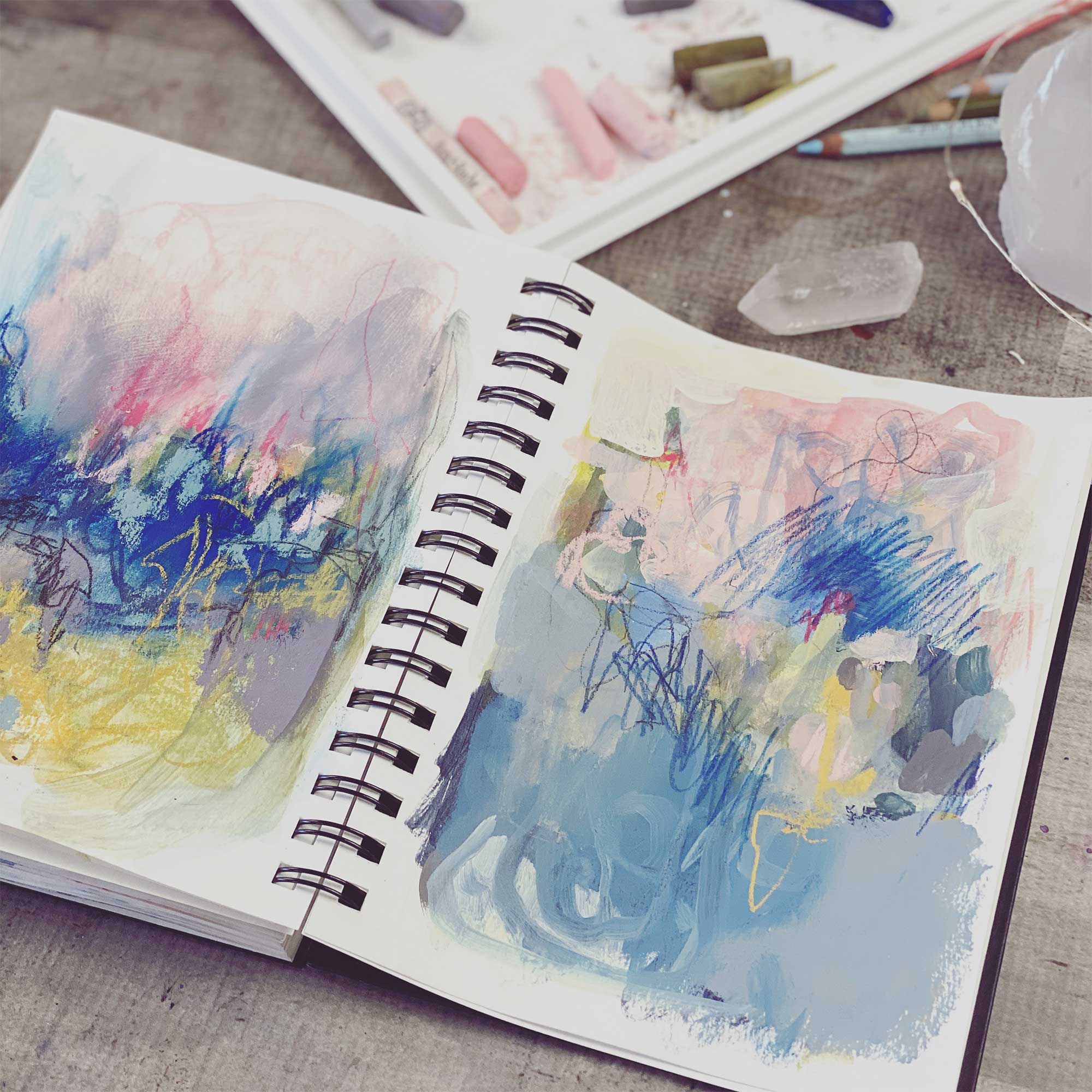
EXPLORATION 2
Color Play
In preparation for our lesson this month, choose the colors you want to use for Exploration 3 (Abstract Landscapes) and play with these colors on some pages in your sketchbook. Play with different mediums, marks and patterns. Just have fun with this! Let your inner child play!
EXPLORATION 3
Abstract Landscapes
Joan Mitchell often said that she “carried landscapes inside her” and then expressed them through her artwork. She claimed to paint the feelings the landscapes left with her rather than imitate nature. Why don’t we try to do the same in a Joan Mitchell inspired piece. Think of a landscape you love or one you remember vividly, now jot down what you see in your minds’ eye. Also note down how this place made you feel! Now, using a limited color palette inspired by your absract landscape – create an abstract piece using layers of spontaneous marks. Trust in the process and let loose! Don’t try to overcontrol to contrive the design. Experiment with different values, lines, marks and shapes, focus on the feelings of the landscape rather than its literal representation. Dive deep into the unknown and trust in the truth that you are worthy NO matter the outcome. Have fun!!!!
*You will see me do this exploration in our Video Lesson!
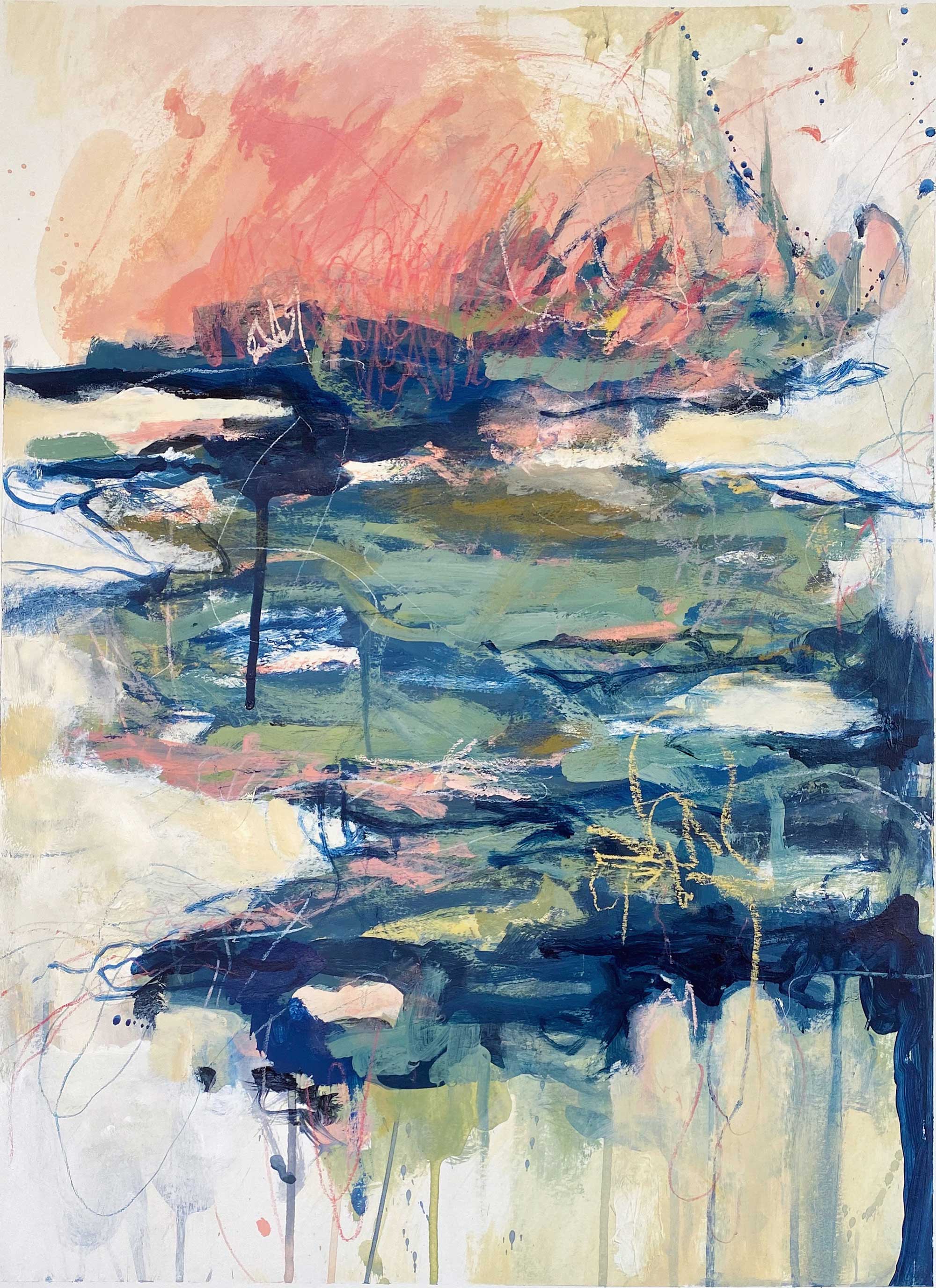
MONLTHLY ART PROJECT
Abstract Landscape
I’m so excited to share this lesson with you guys! As always, this abstract took me on quite the rollercoaster. The battle between the intuitive mind and the logical mind is real but this process always pushes me to trust myself a little more and to just embrace the unknown.
So with your abstract landscape in mind and the emotions and colors of this place, jump into this work with an open mind and heart. Let your inner child come out and play and simply enjoy the colors and textures of paint, pastel and paper.
STUDIOWORKS PODCAST
issue fifteen
You can also listen to this month’s issue of the Studioworks journal. I find I love listening to books, podcasts and music while I draw, paint or go on a long walk. Enjoy.
Studioworks : issue fifteen
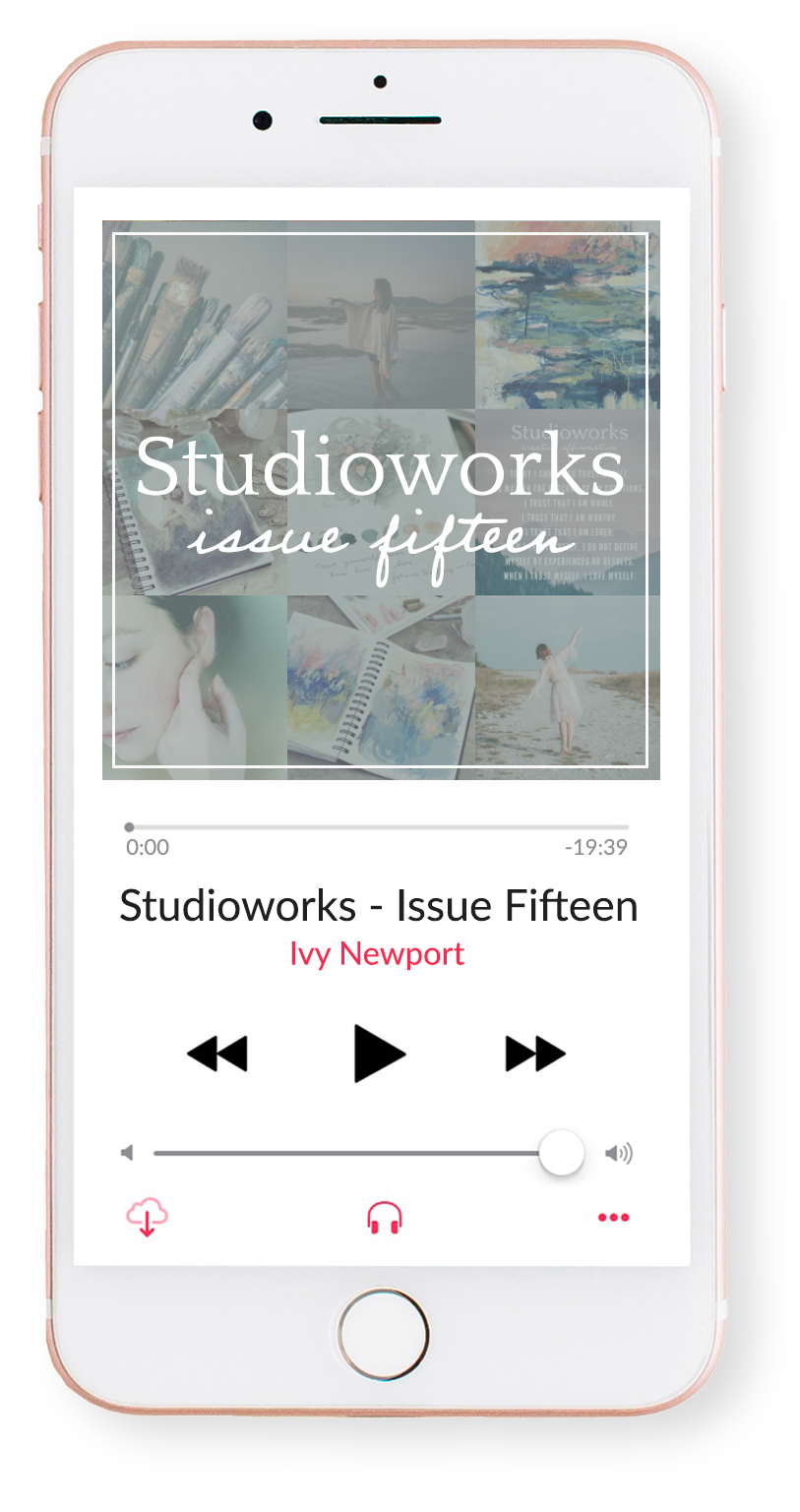
inspiration: curated
One of my favorite things to do is to curate inspiration. From Pinterest boards to books, resources, playlists and more – I love to share anything that might facilitate learning, expansion, and sparks of curiosity! Being an artist, we naturally crave these things so here are some of this month’s picks from me to you.
BOOKS FOR CULTIVATING SELF TRUST
AND EXPLORING ABSTRACT EXPRESSIONISM
MUSIC PLAYLIST
I had so much fun curating this list. I hope you enjoy!!
PINTEREST BOARDS
INTERESTING ARTICLES & VIDEOS TO CHECK OUT
FAVORITE SUPPLIES THIS MONTH
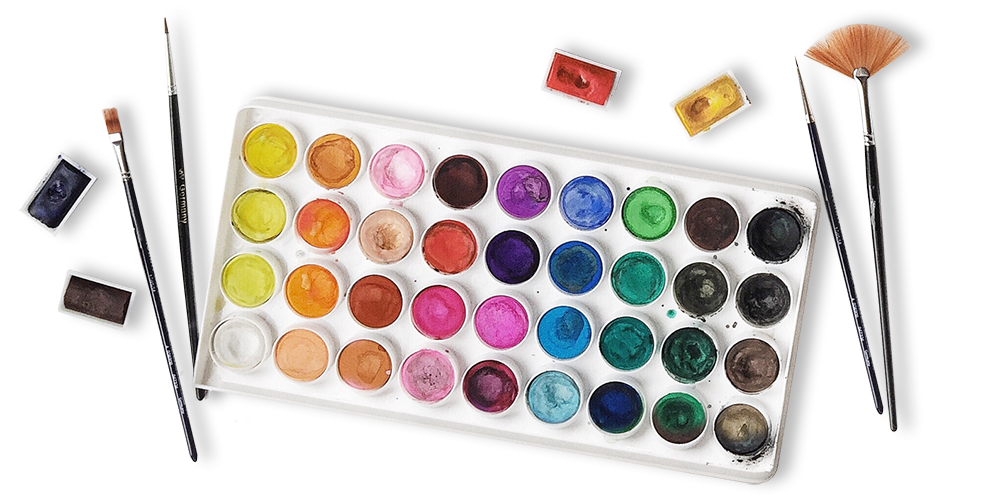
CLASSES TO TRY
These classes carry joy filled learning rooted in nature, art and happiness! I highly recommend checking them out if you haven’t already. Enjoy!

© 2019 IVYNEWPORT, LLC ALL RIGHTS RESERVED.

